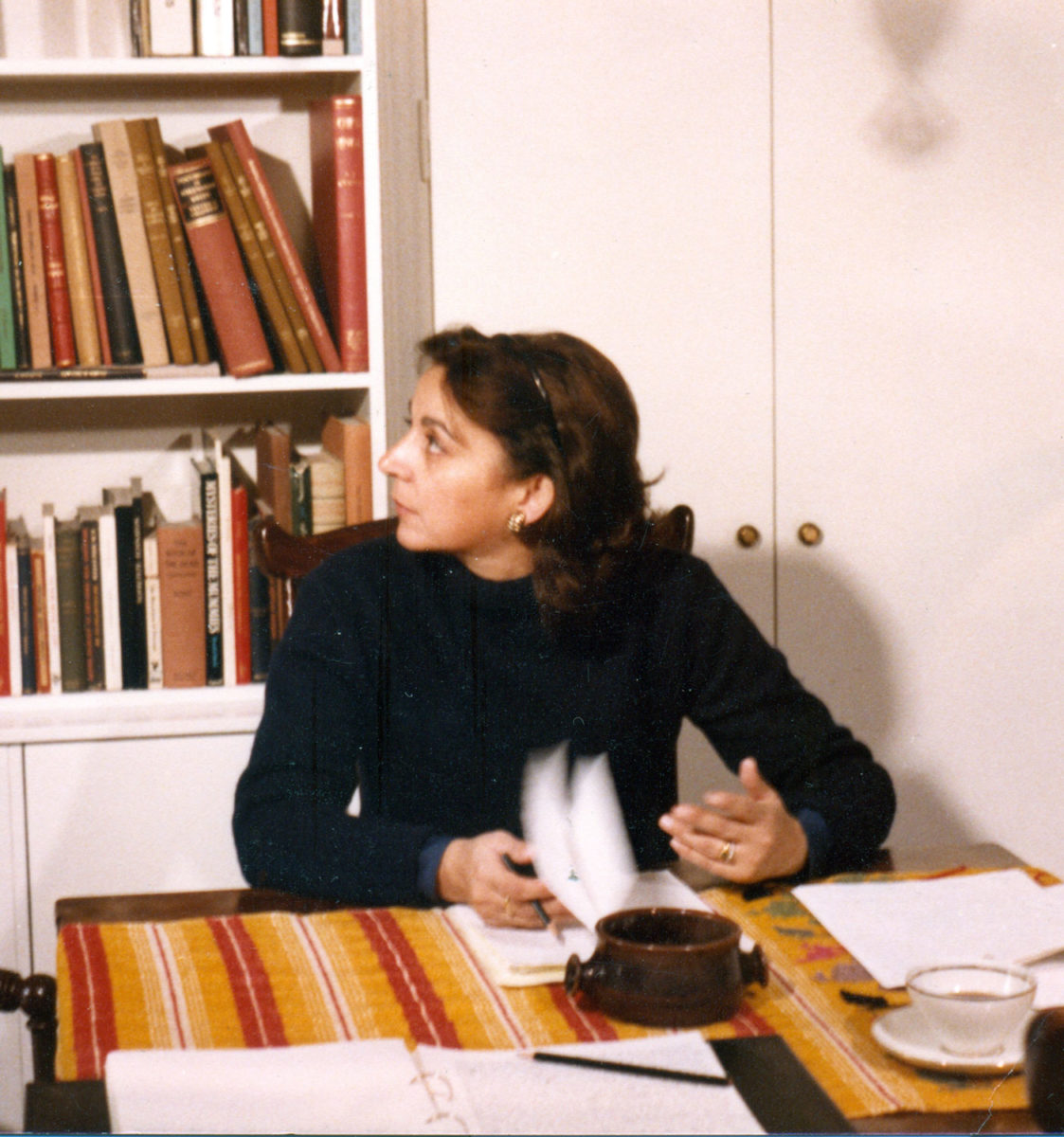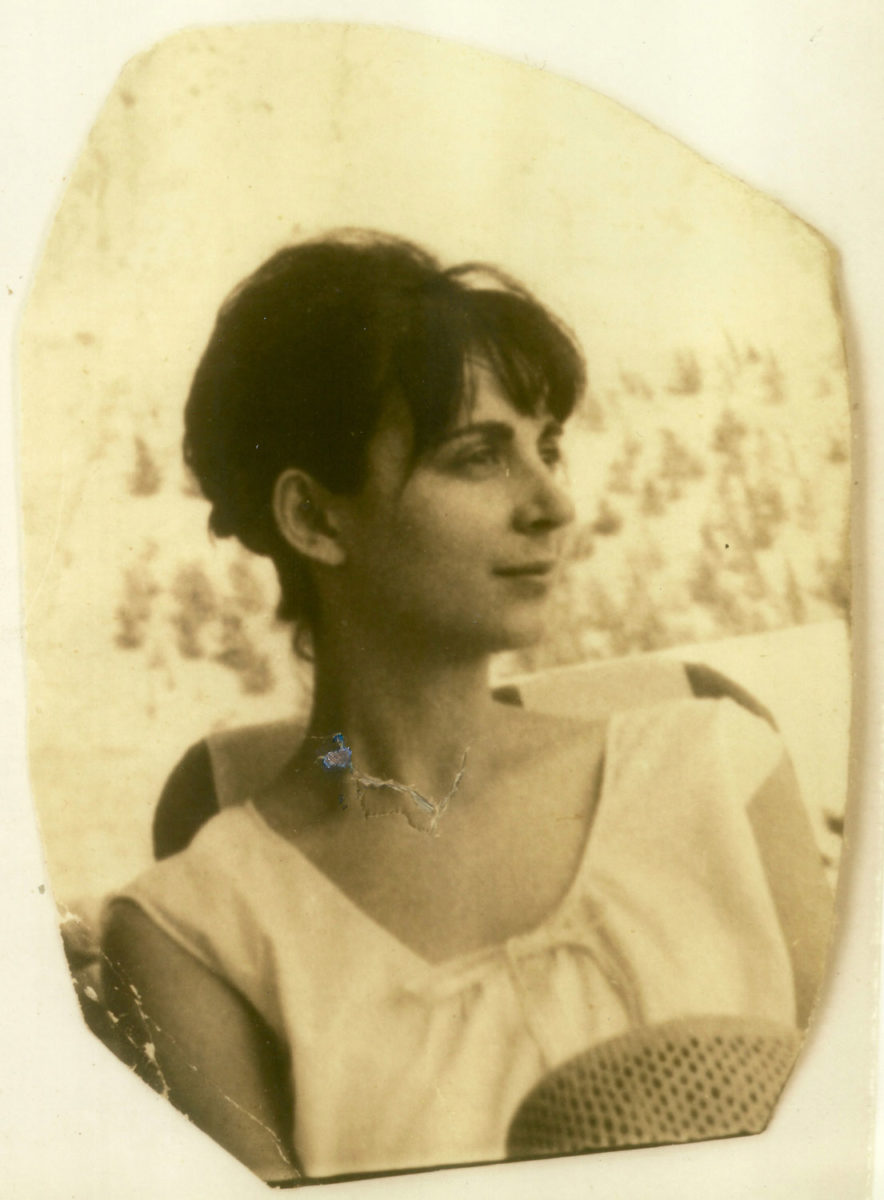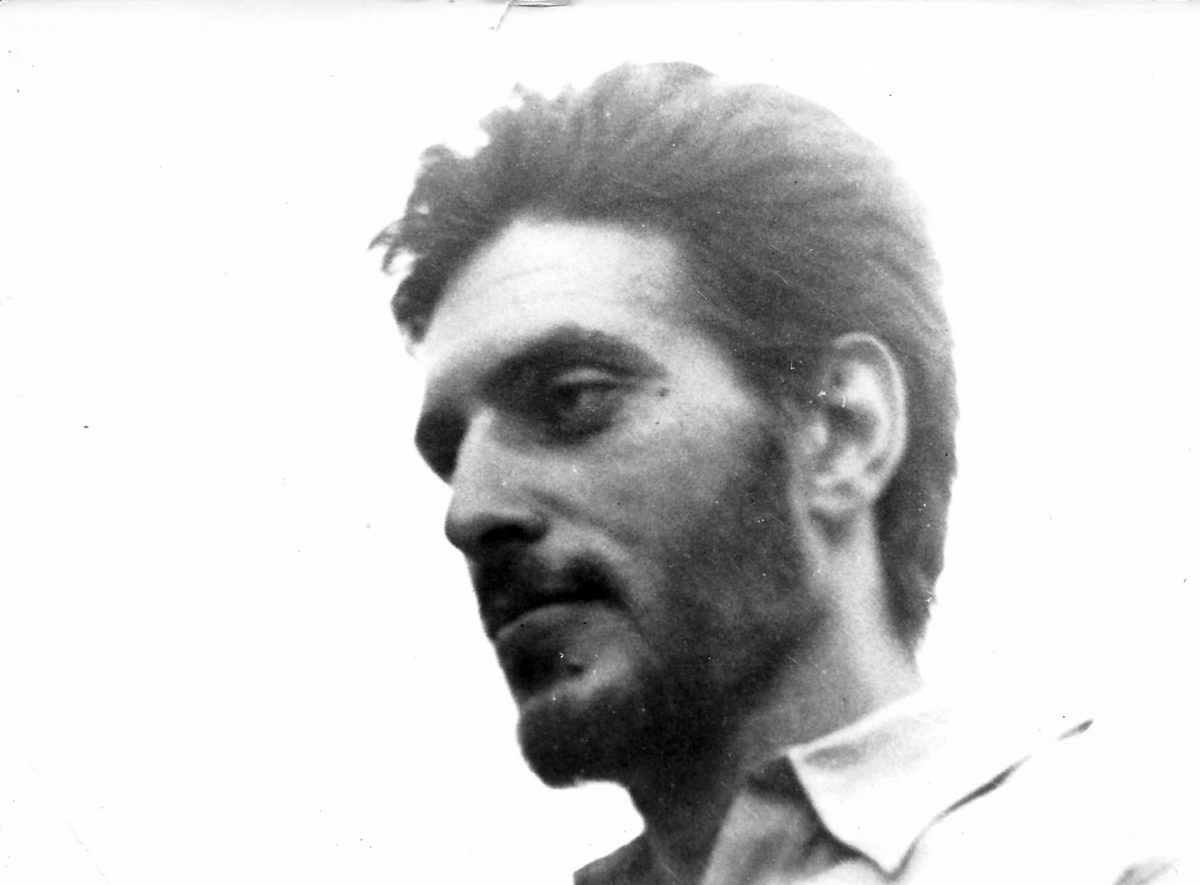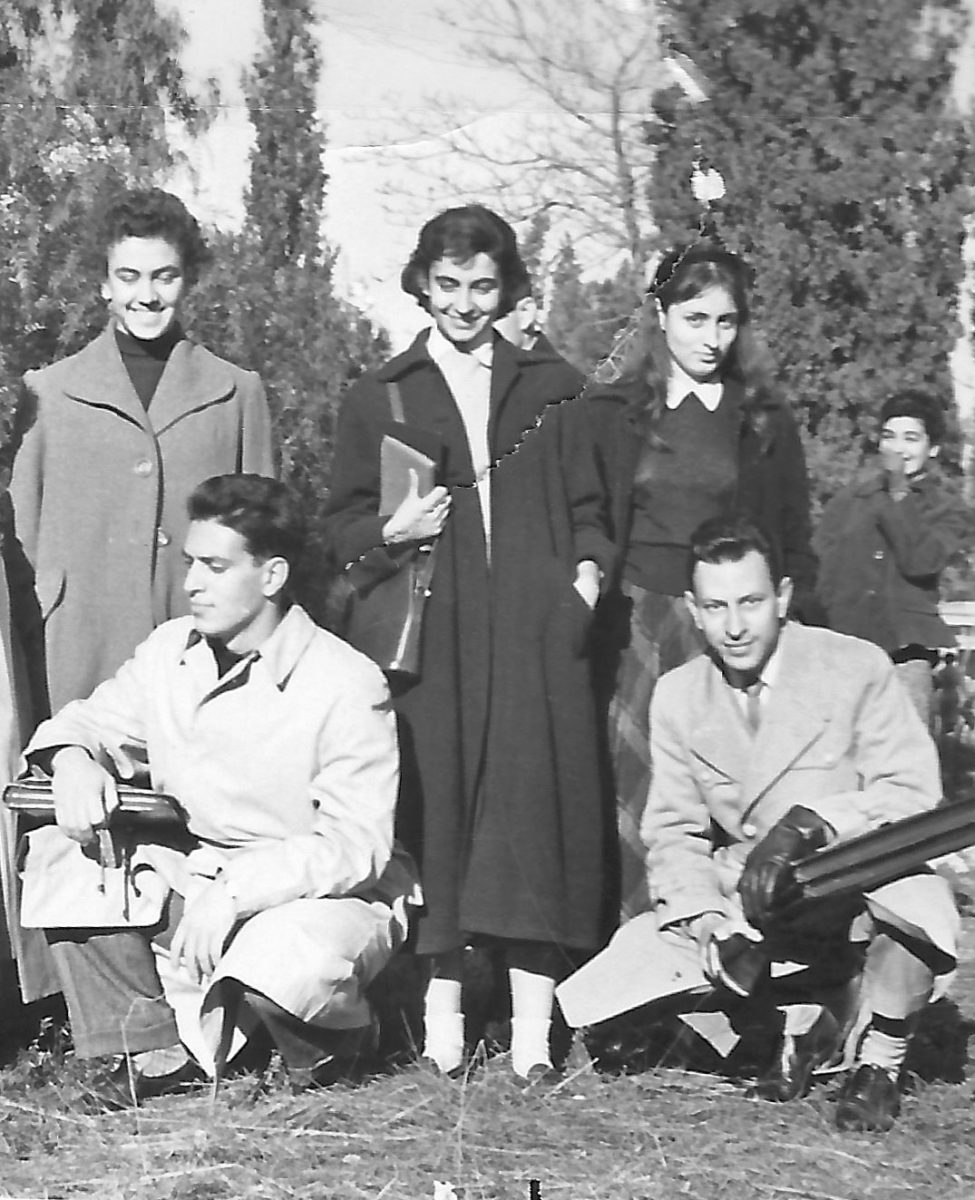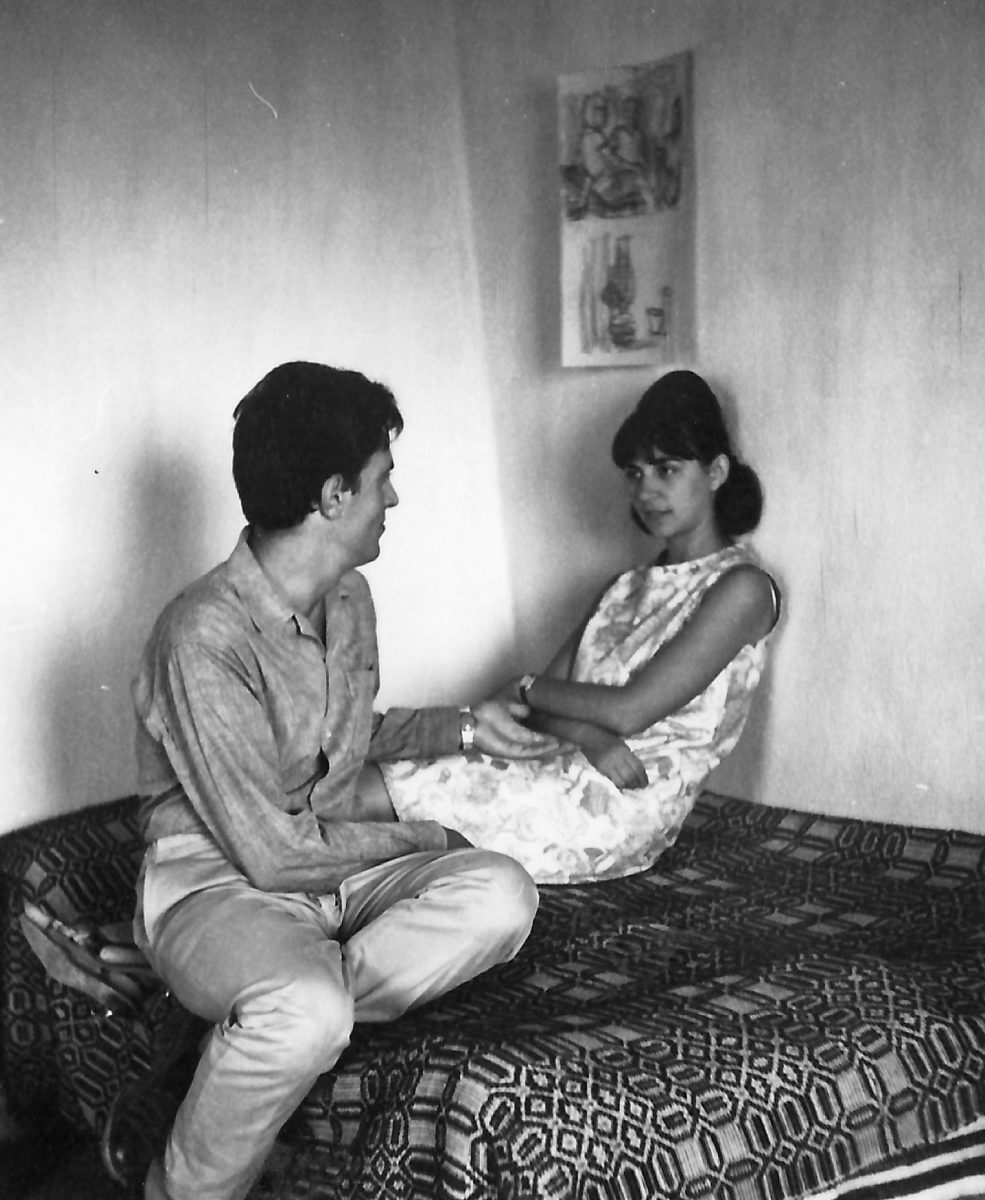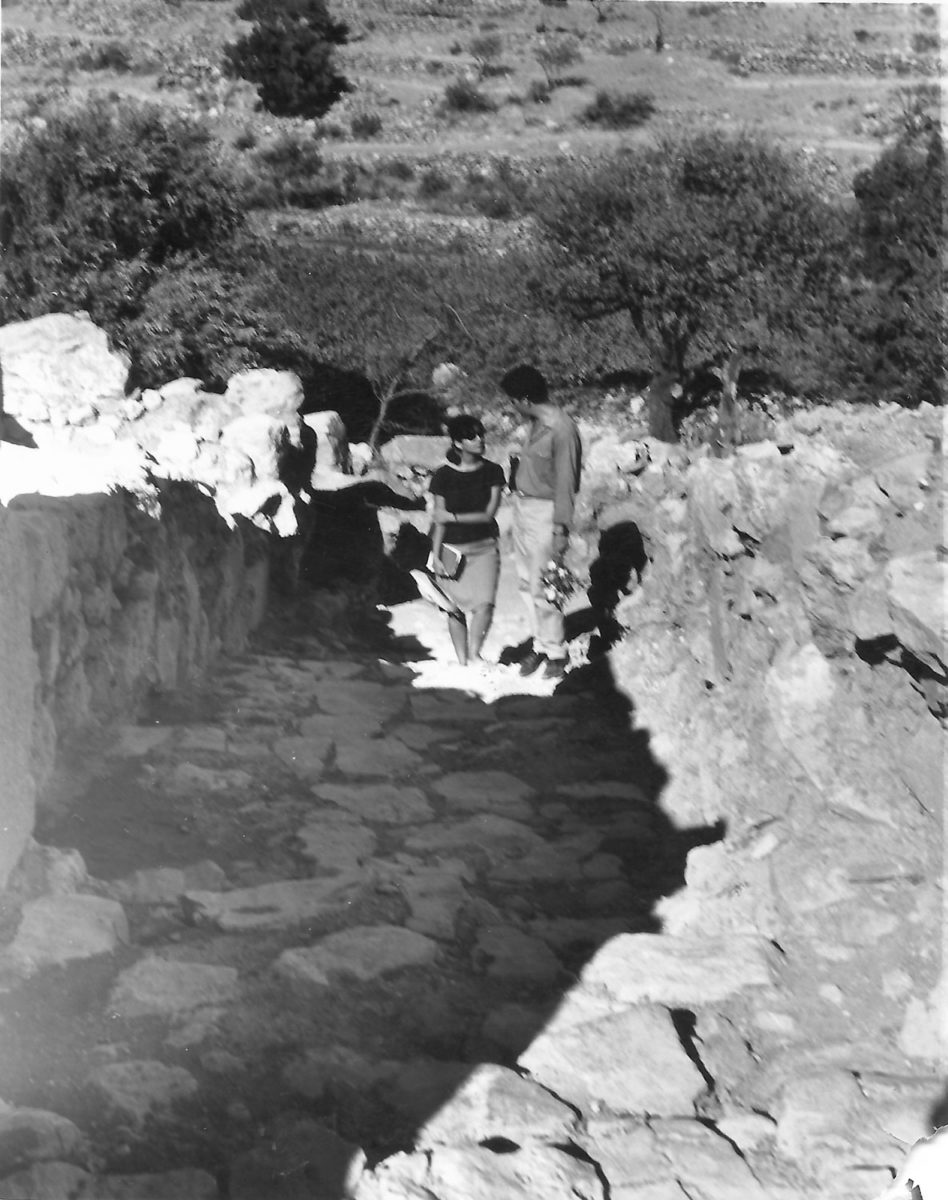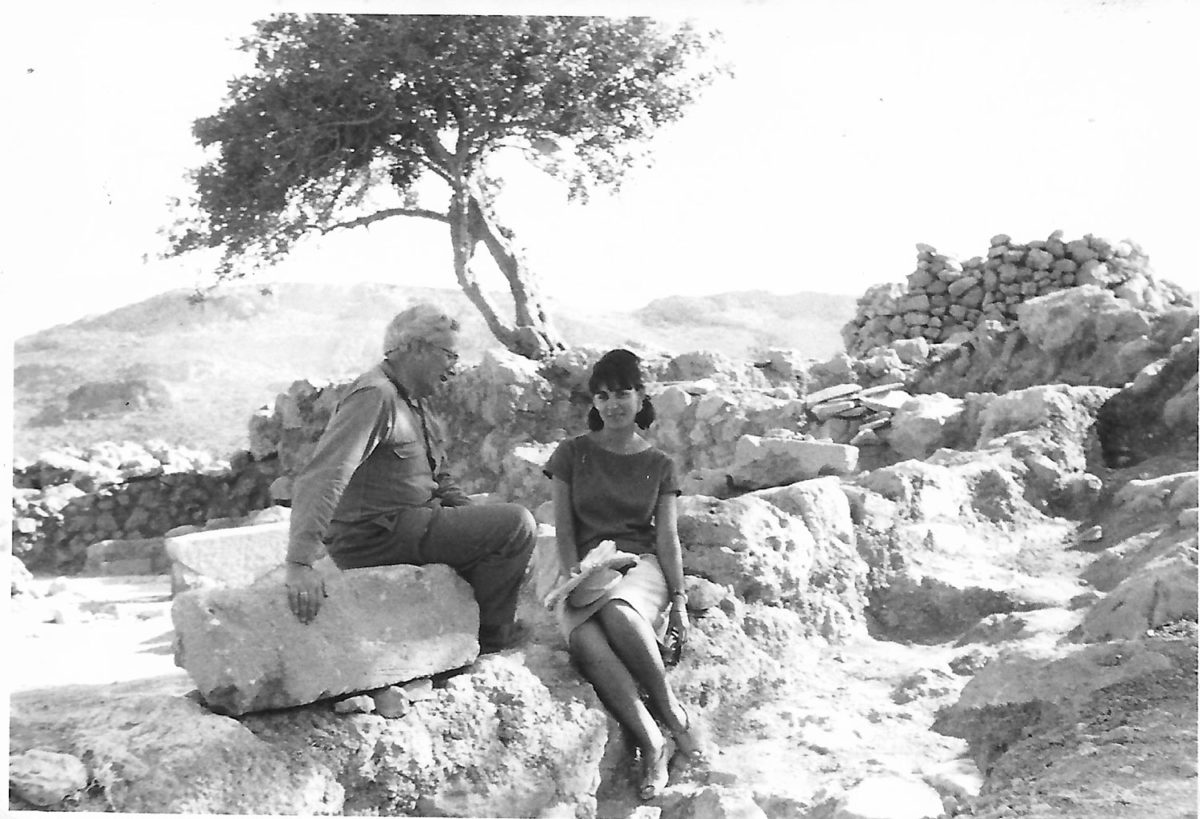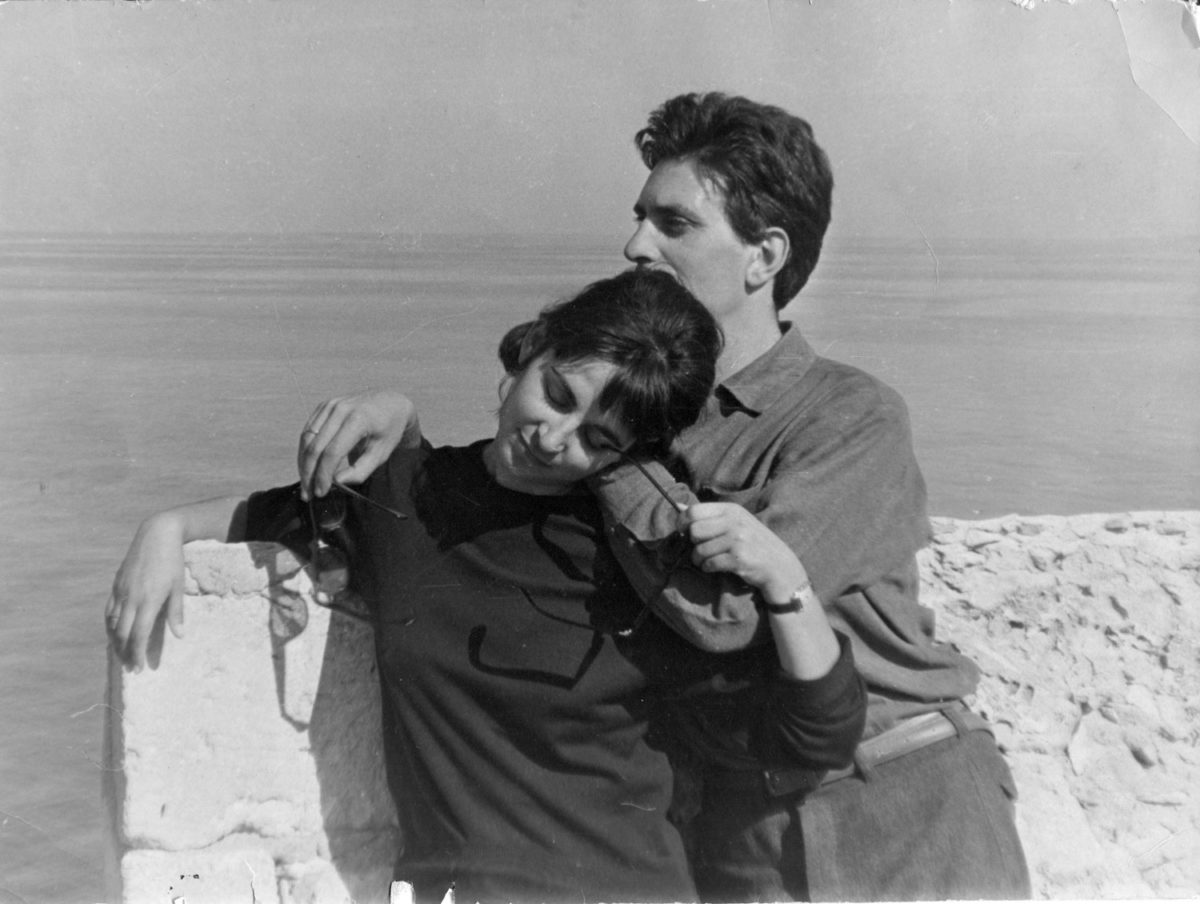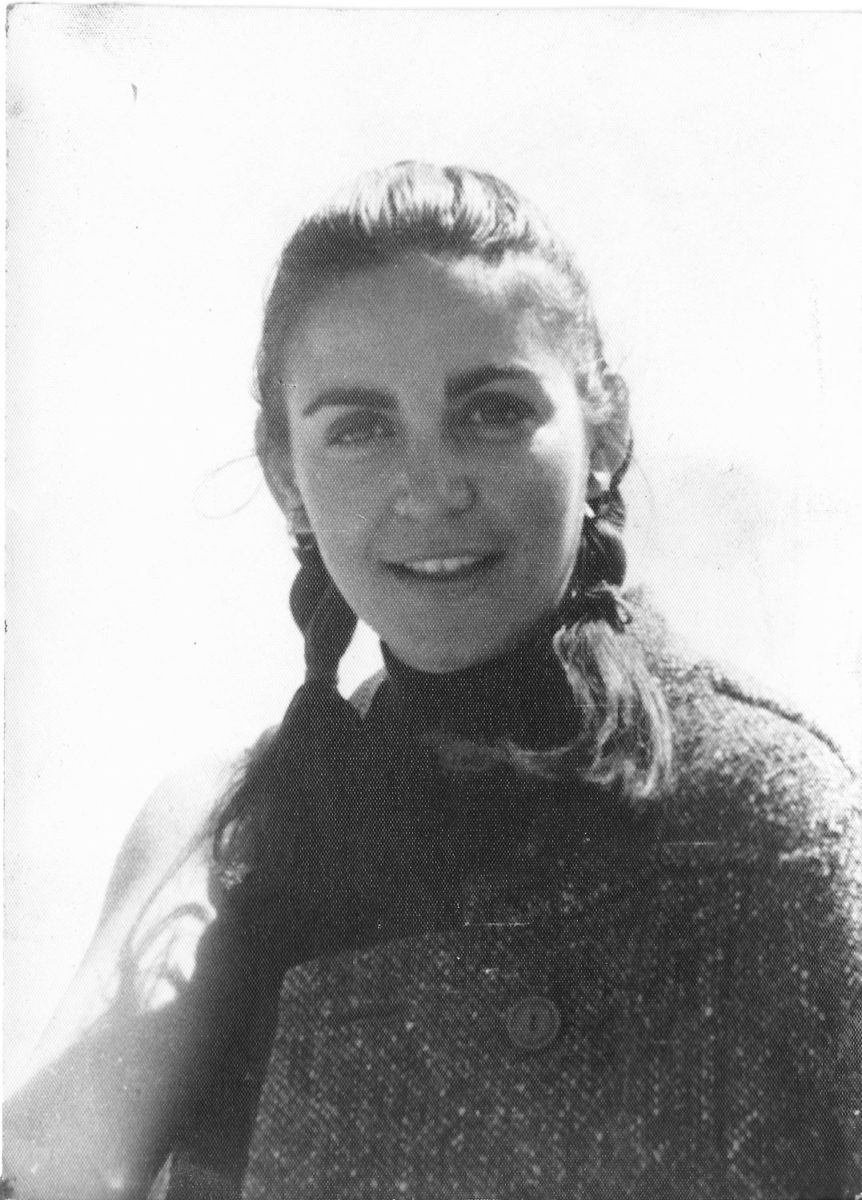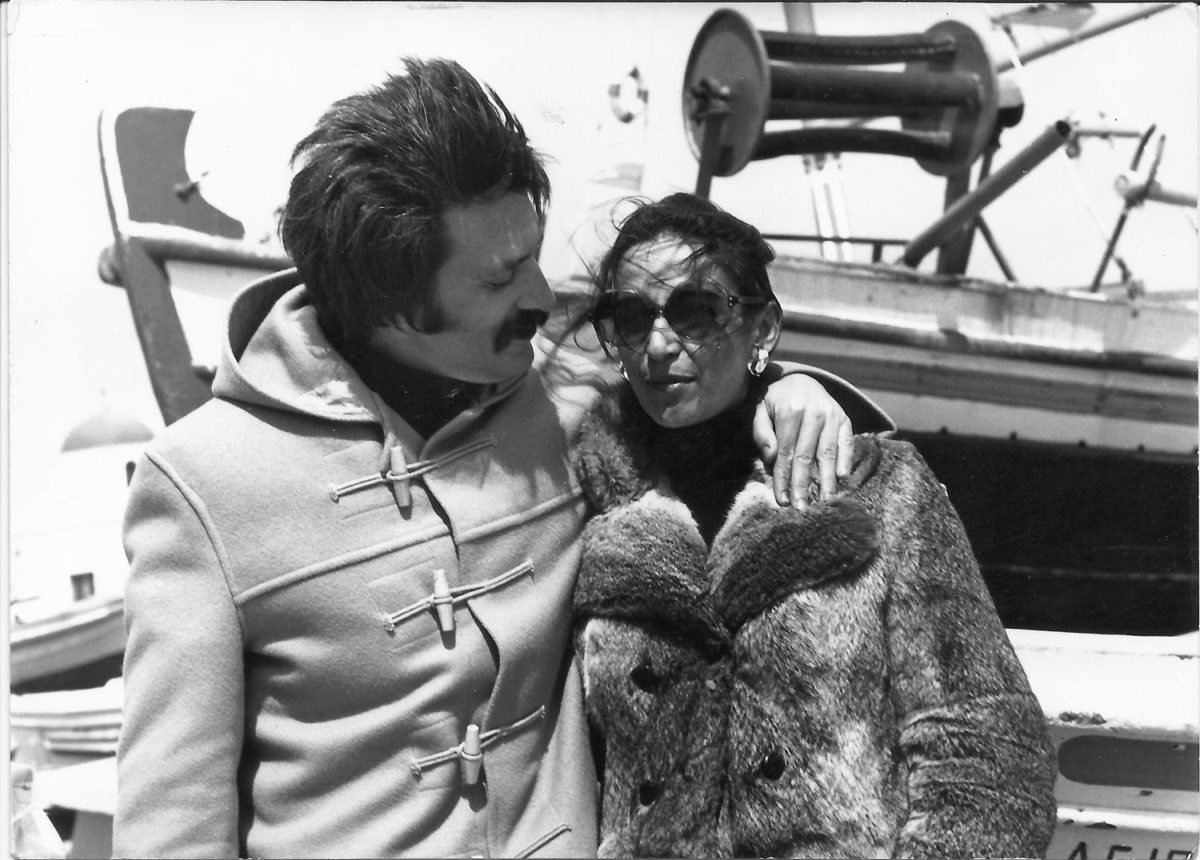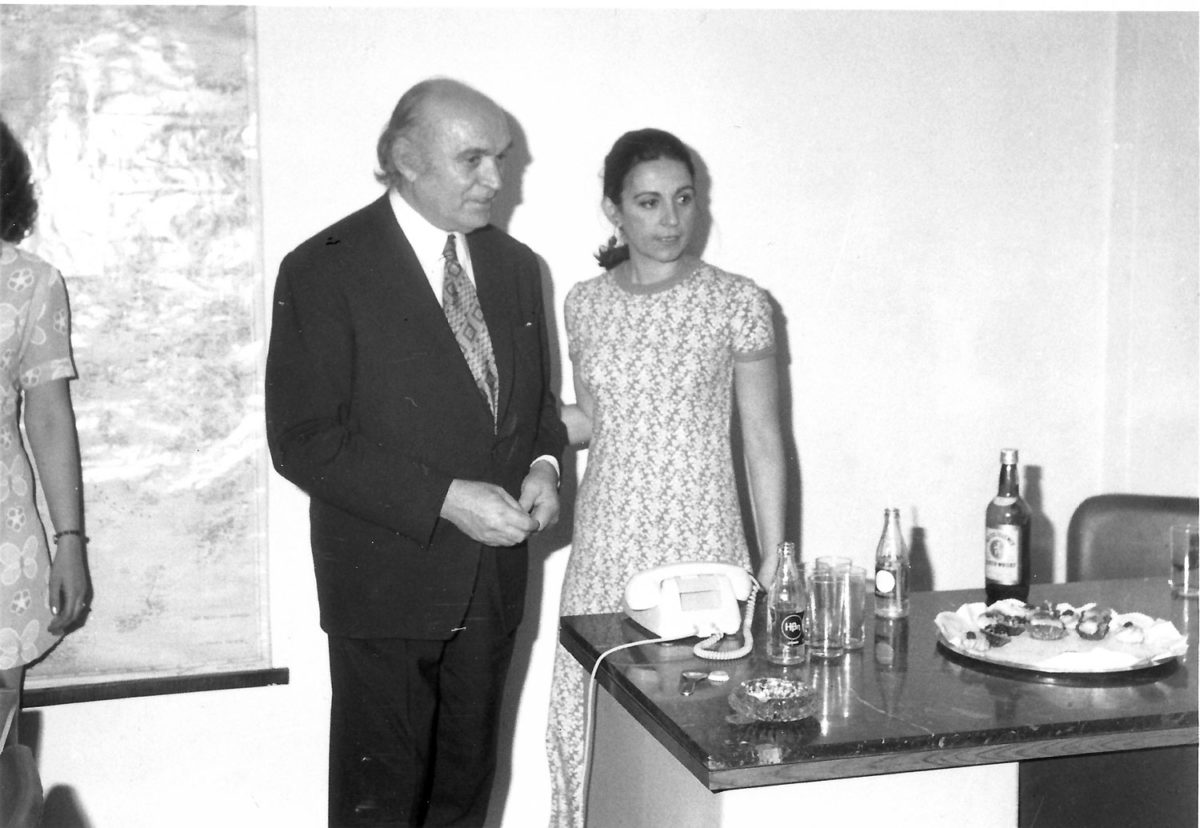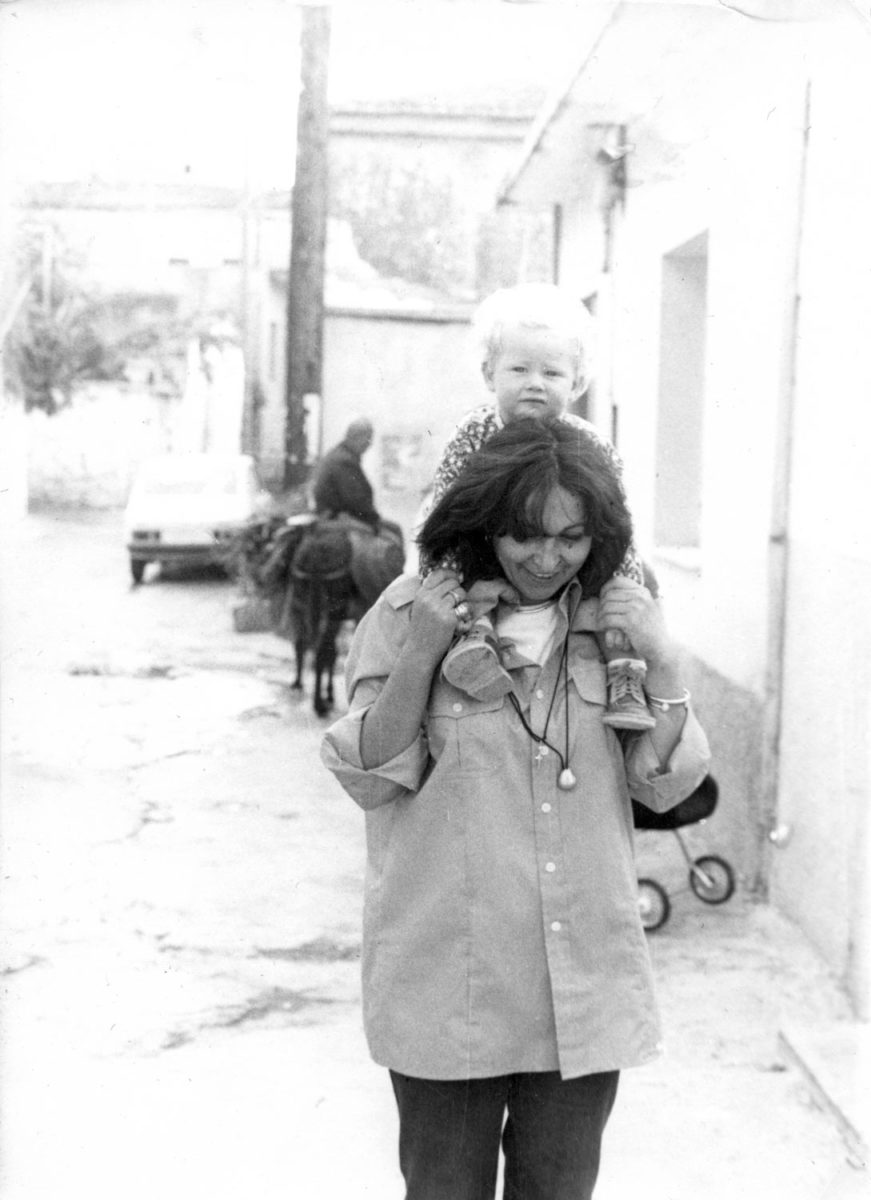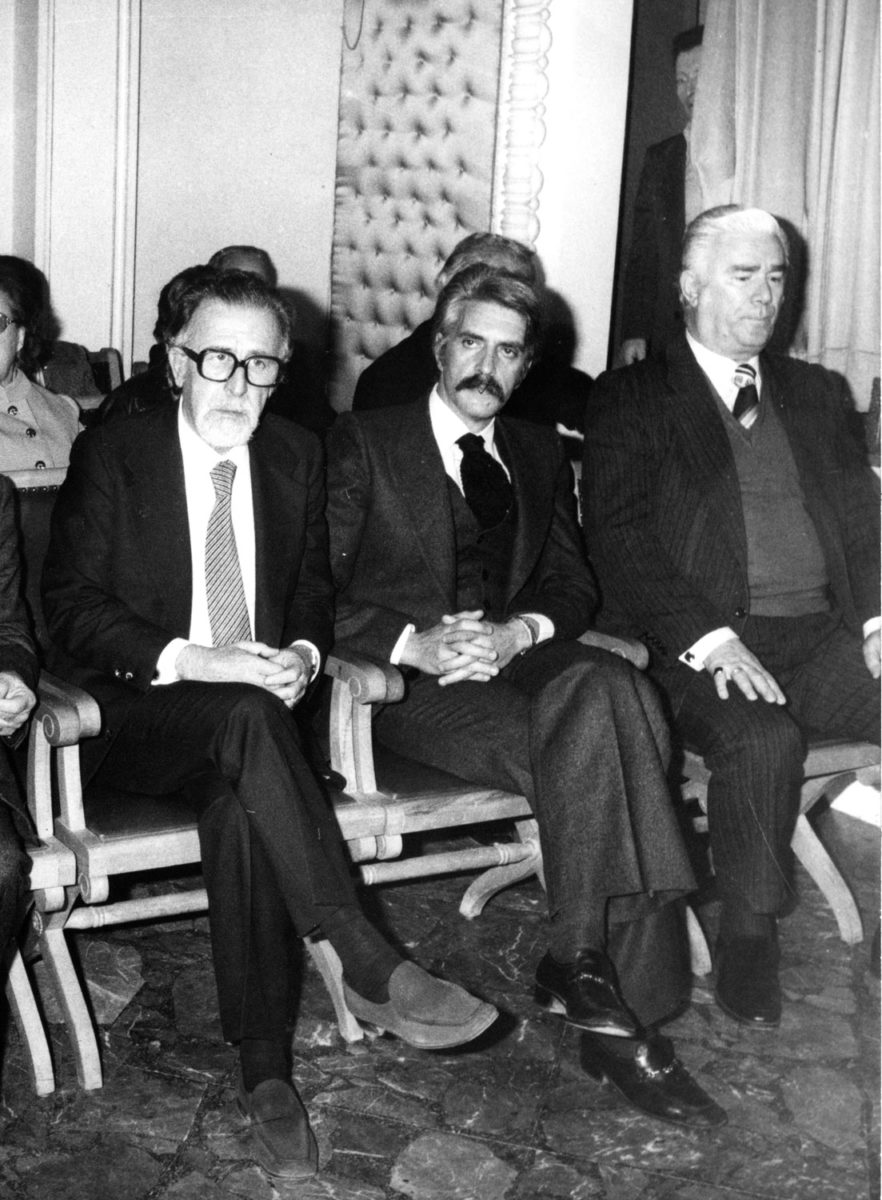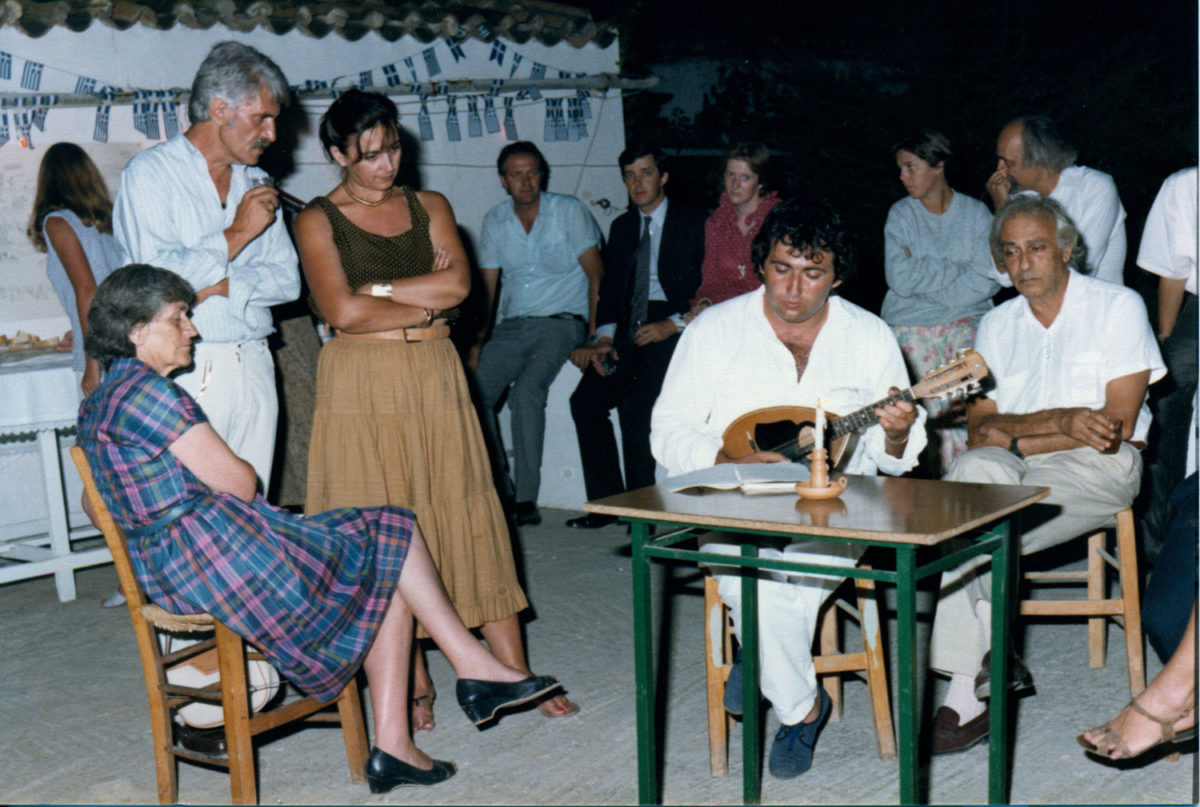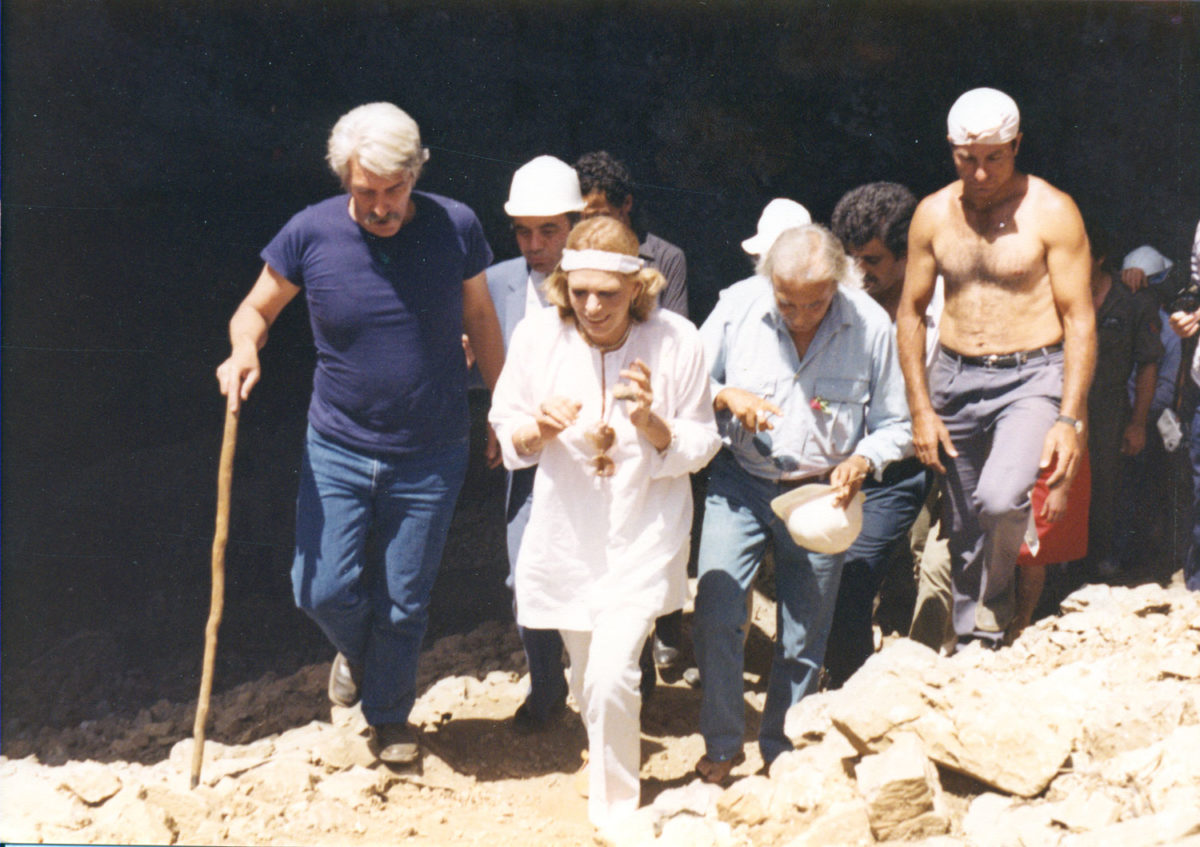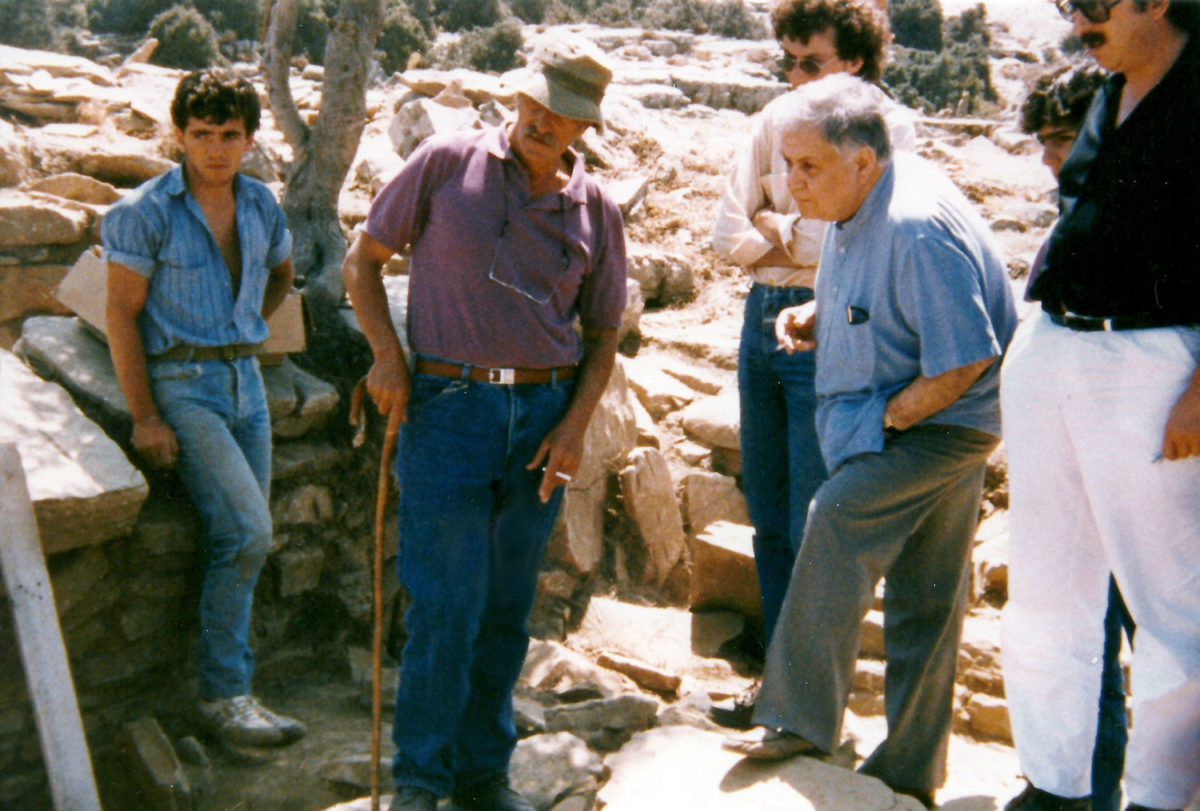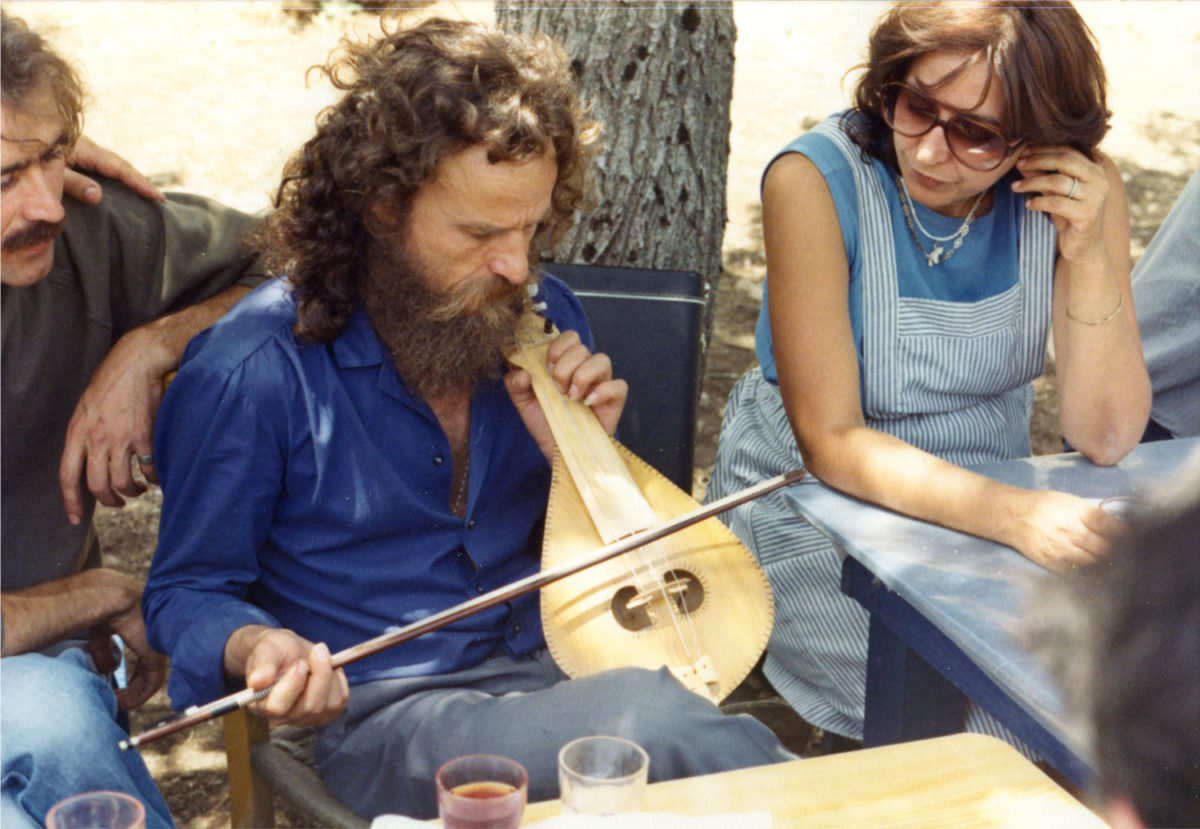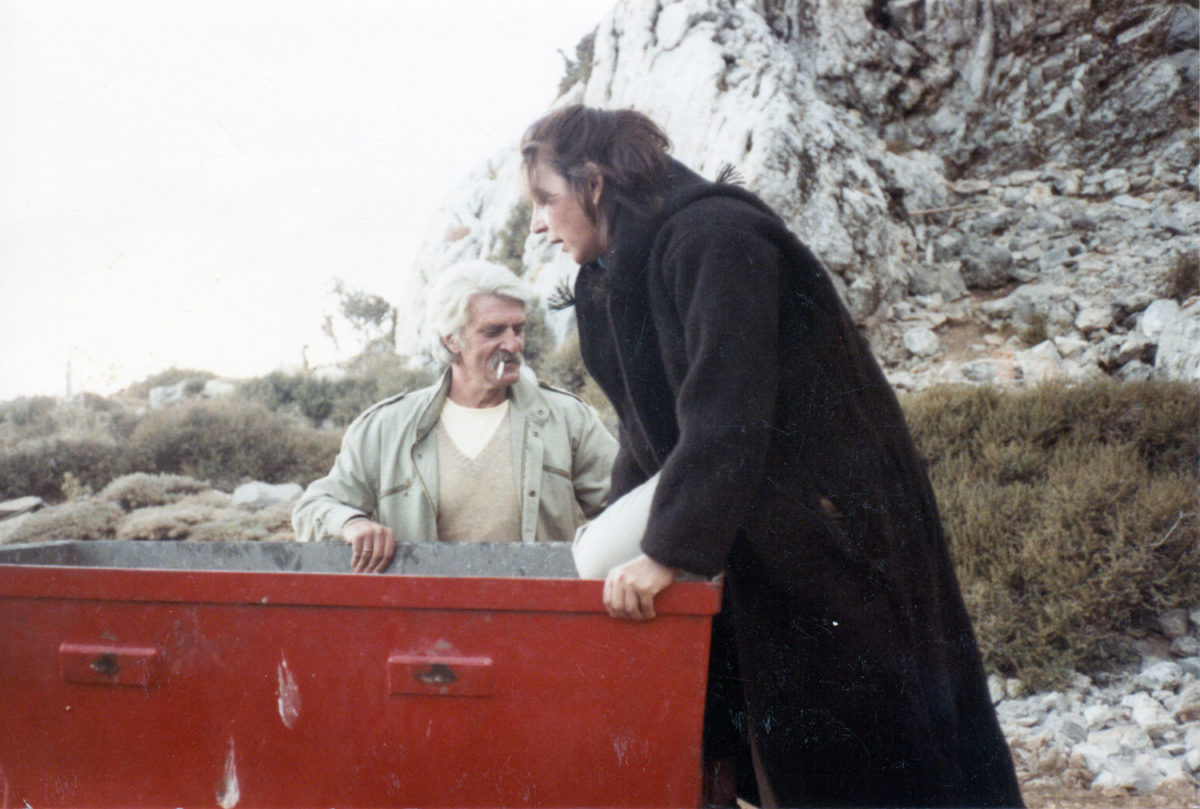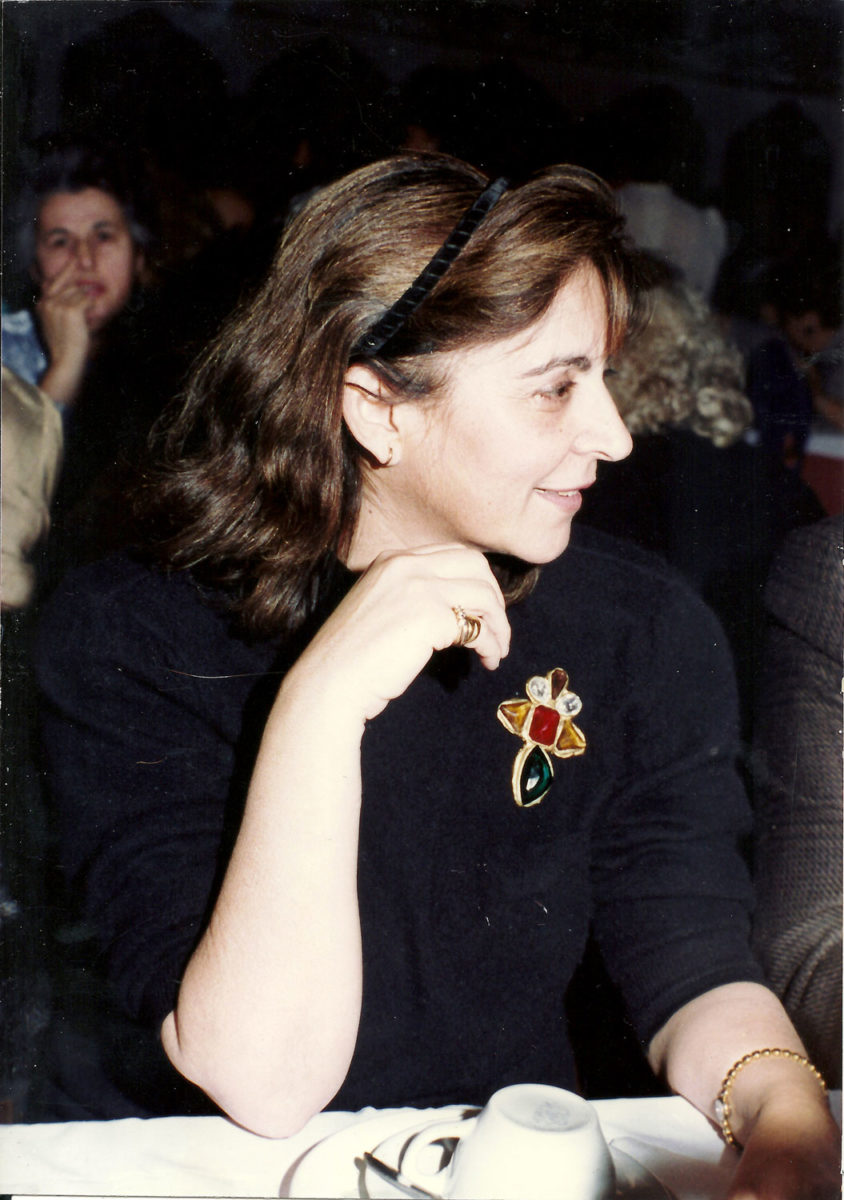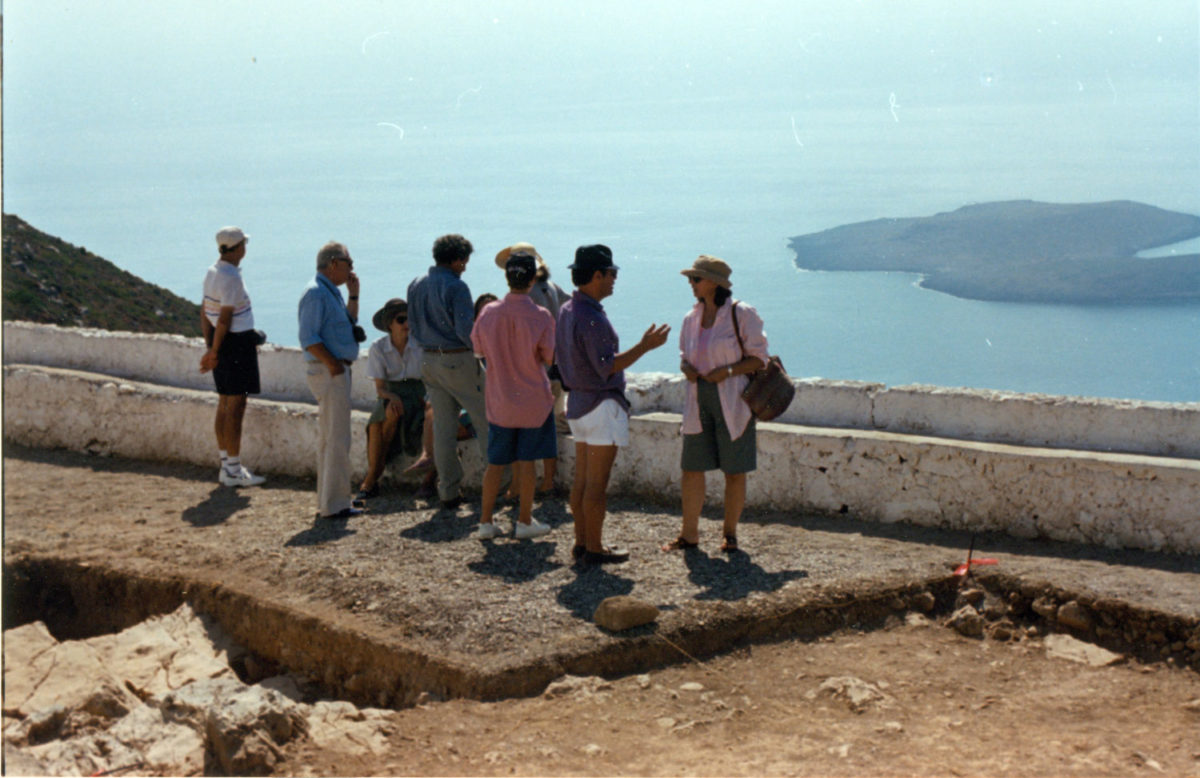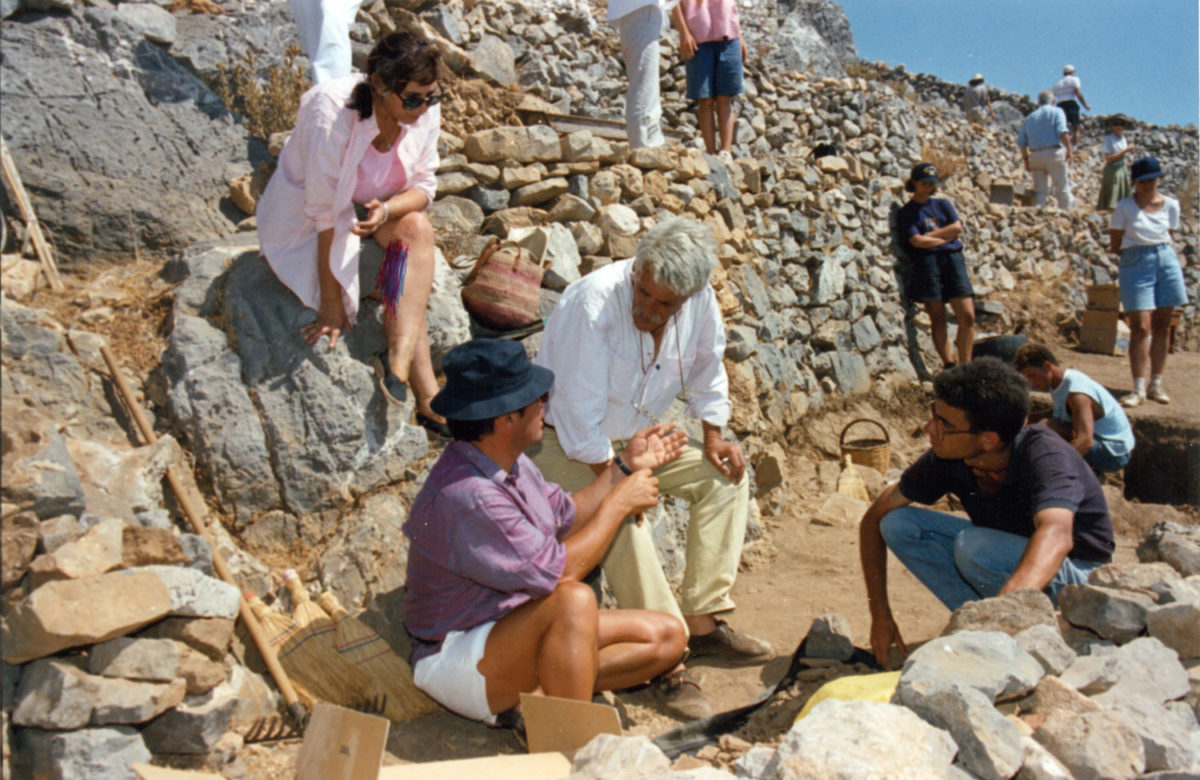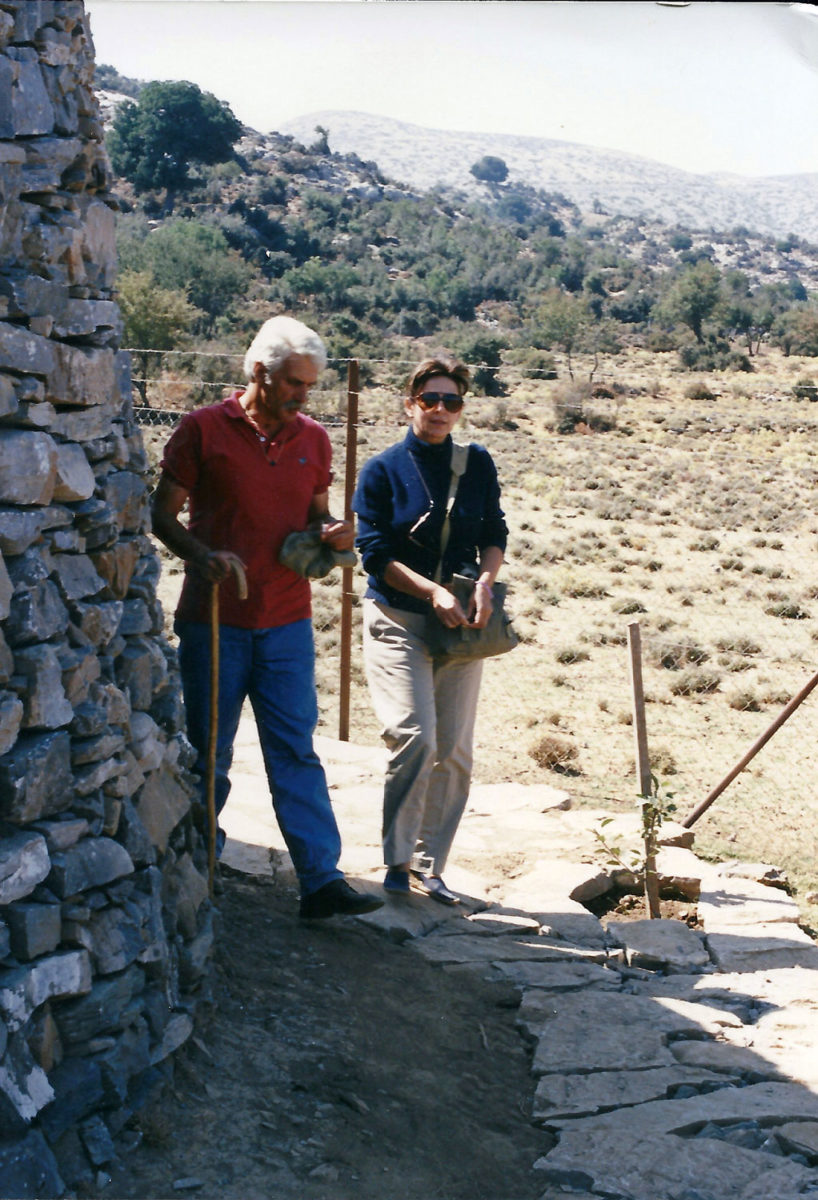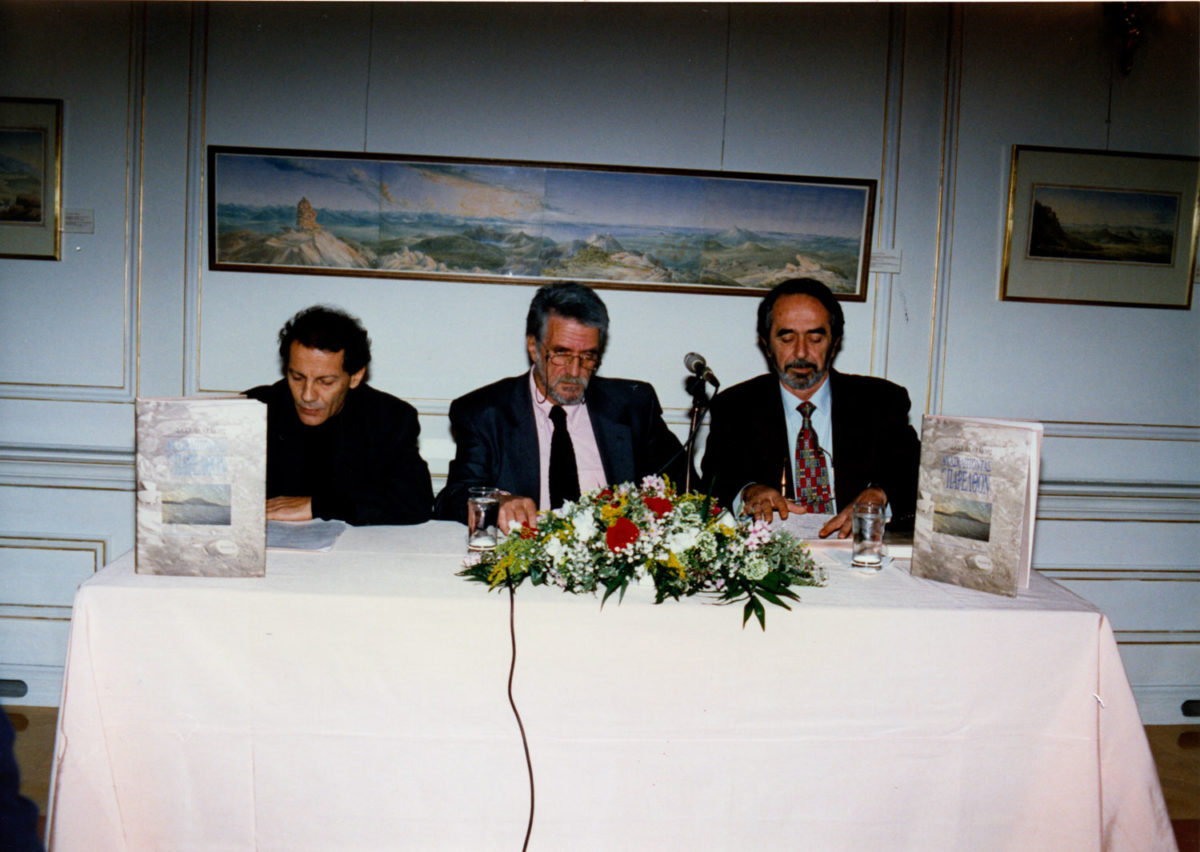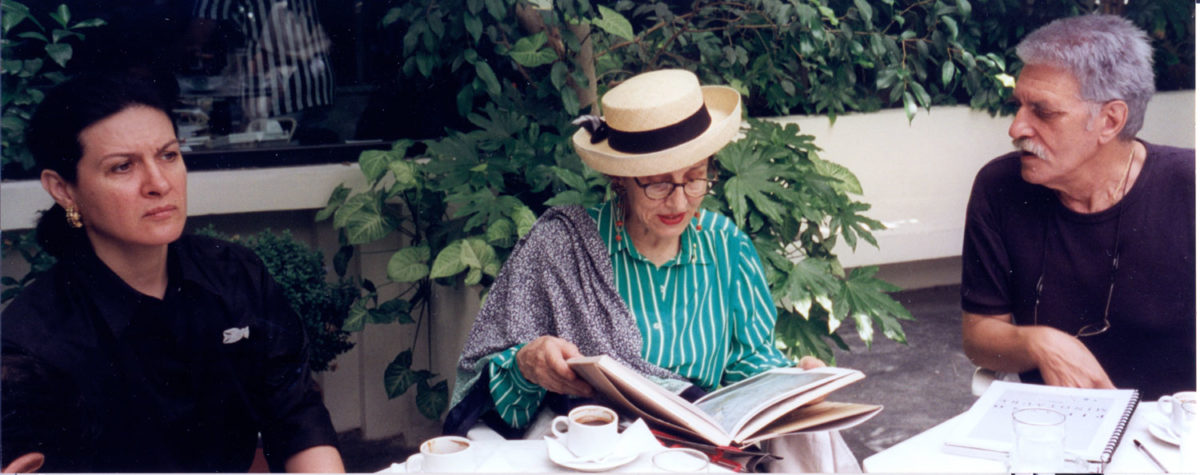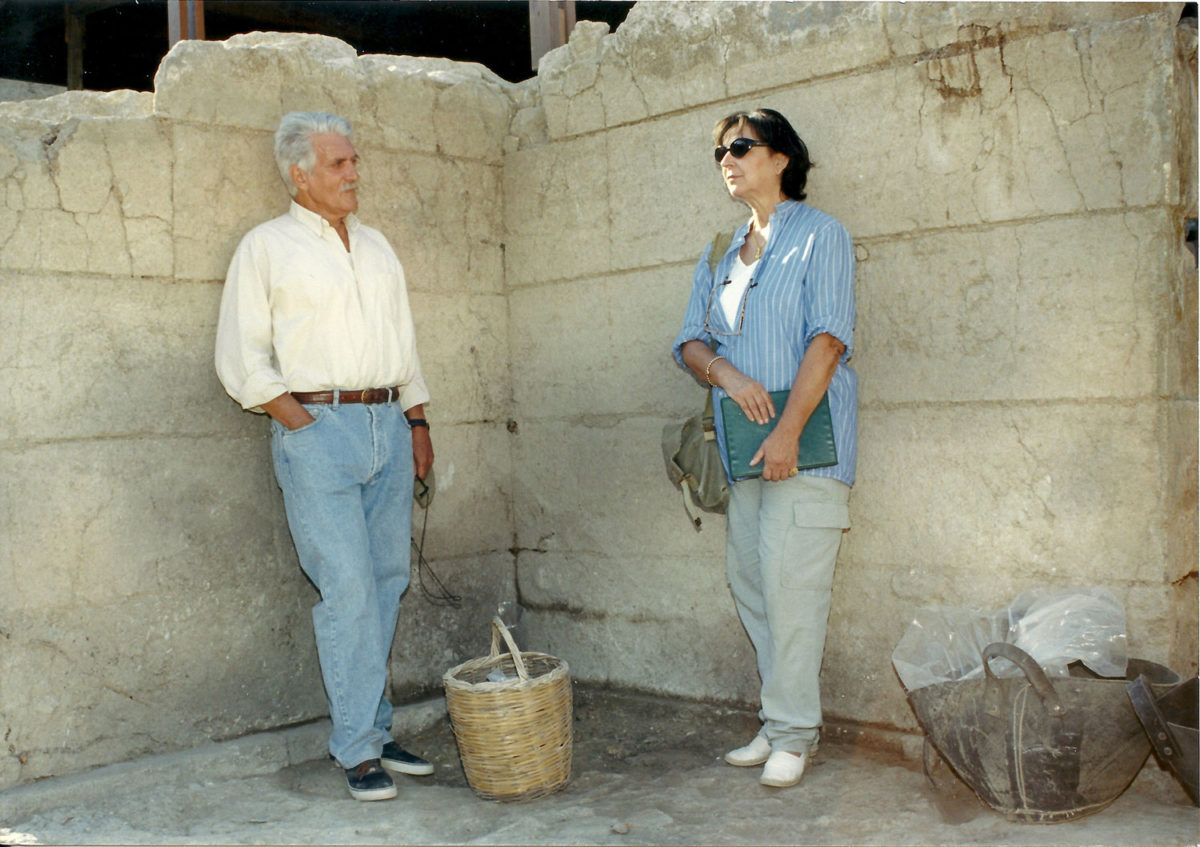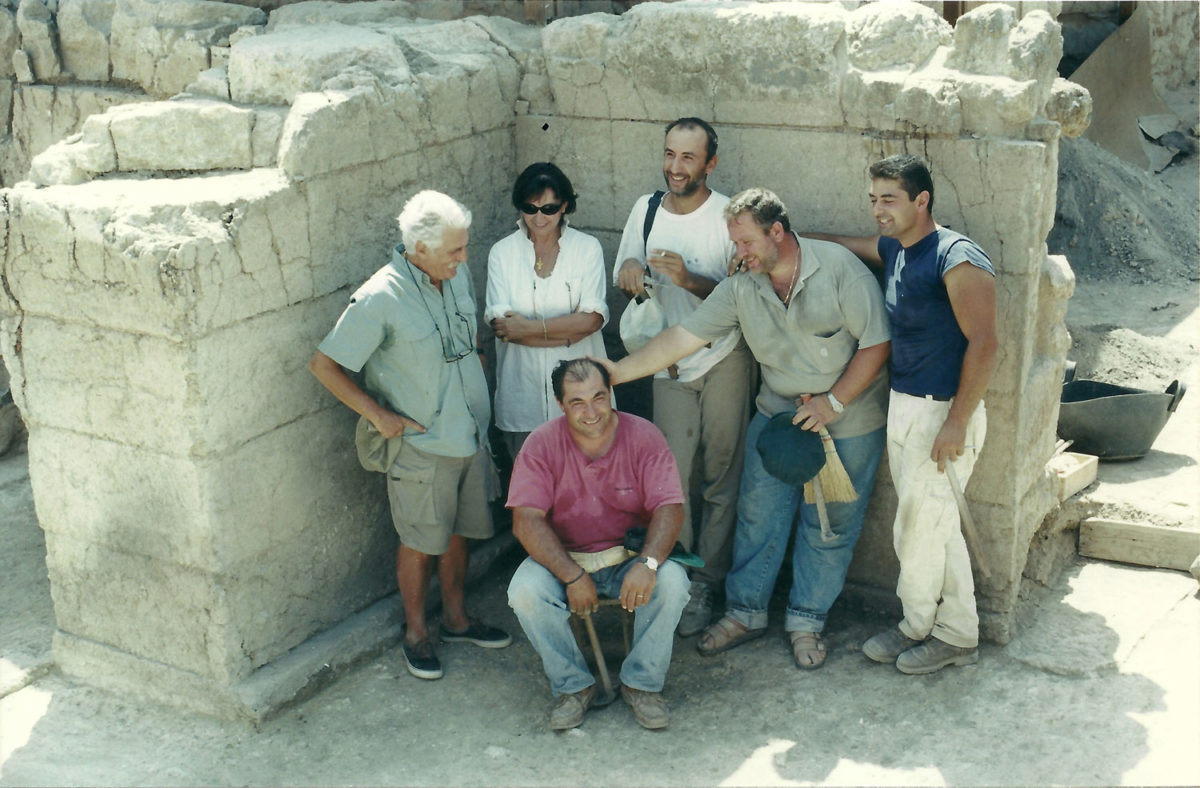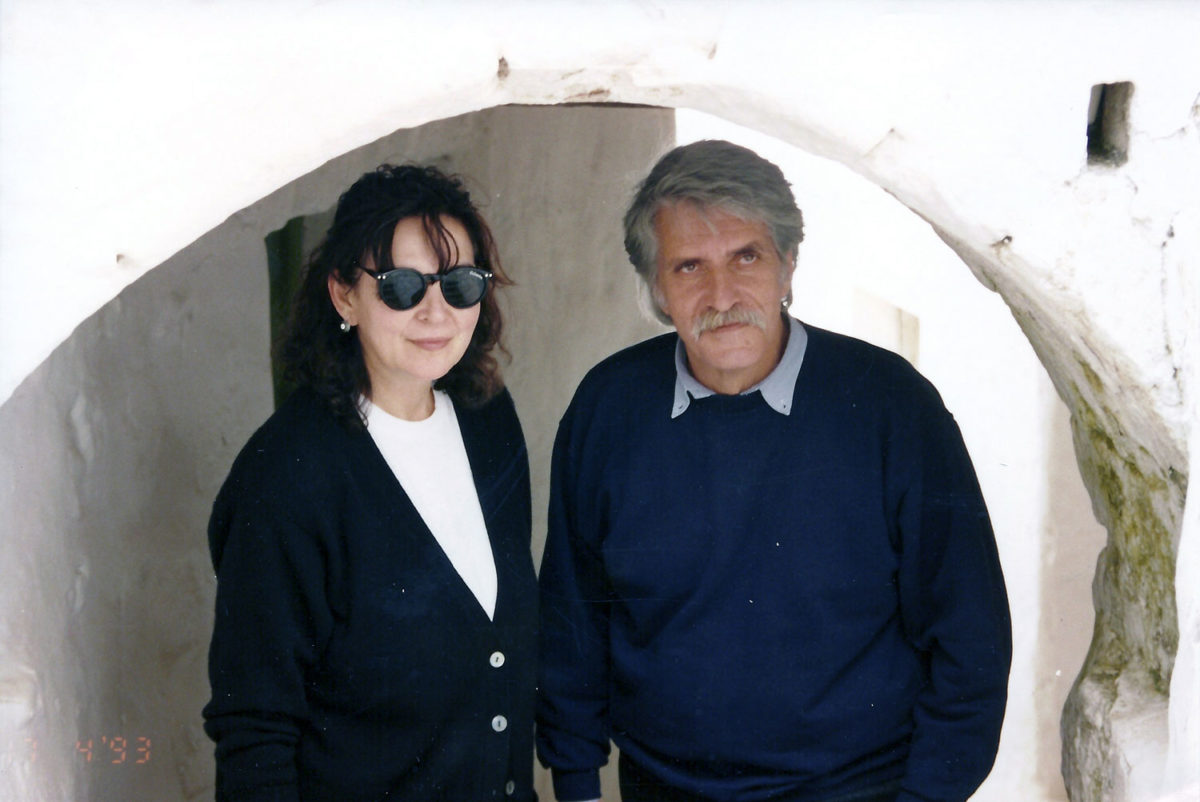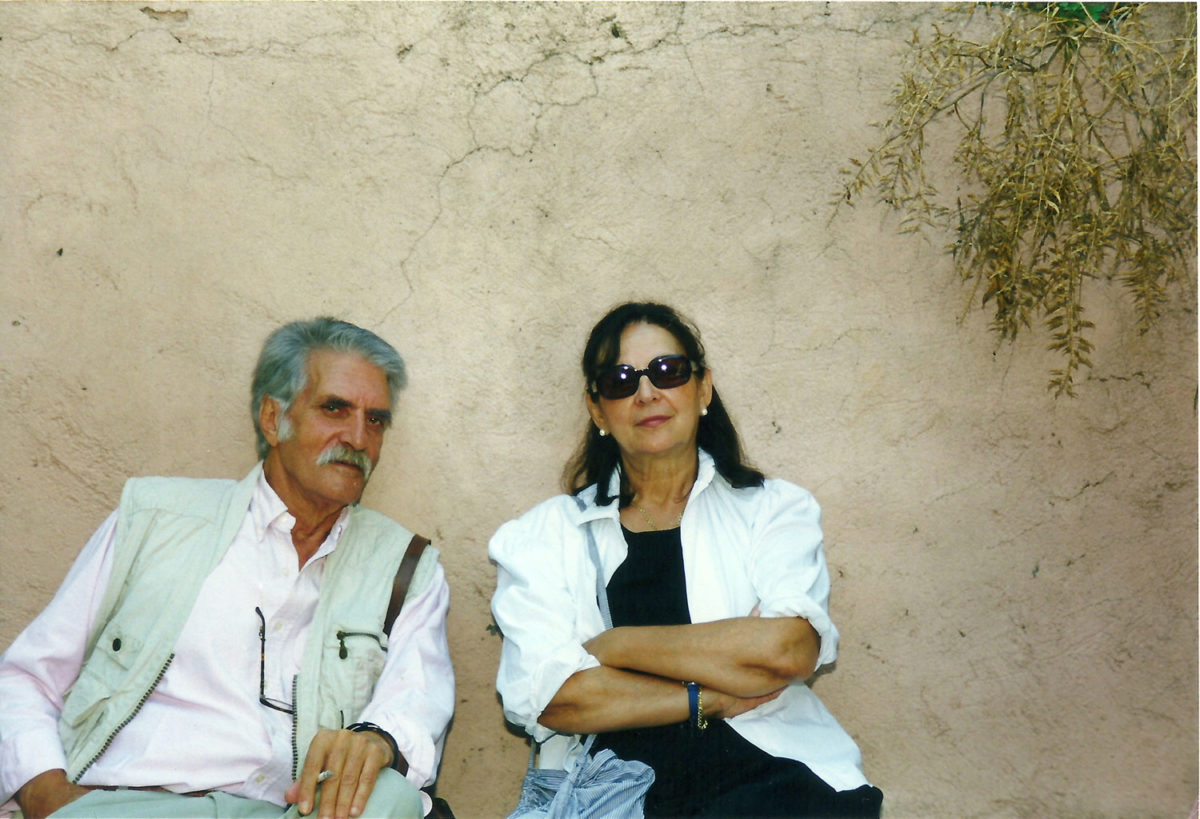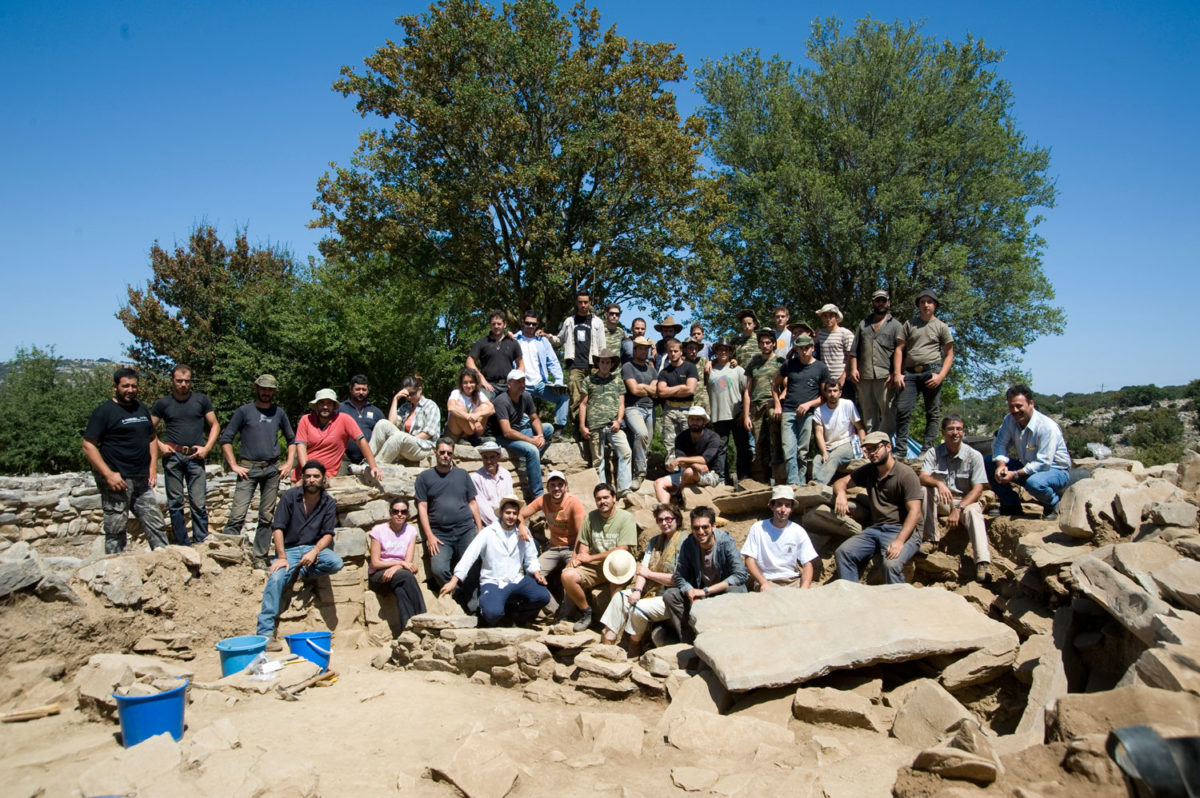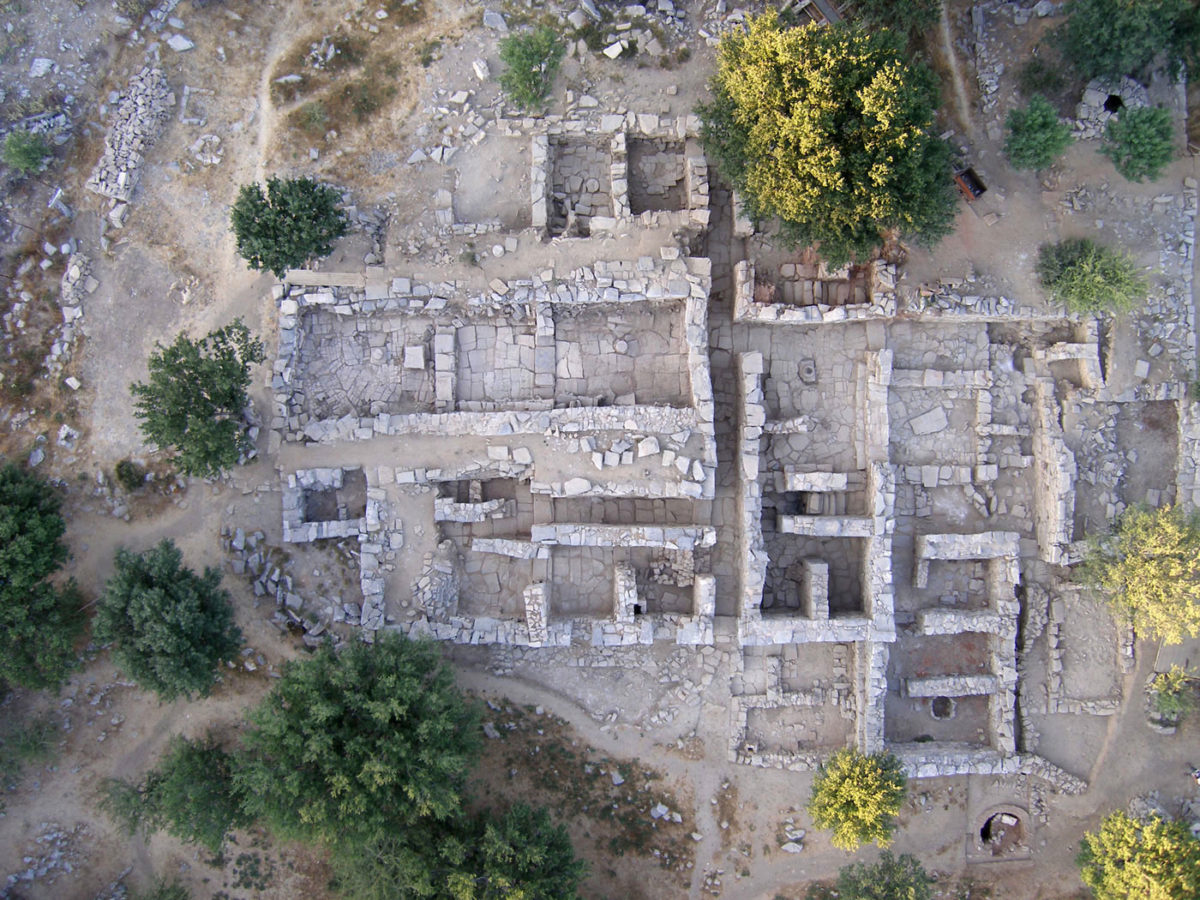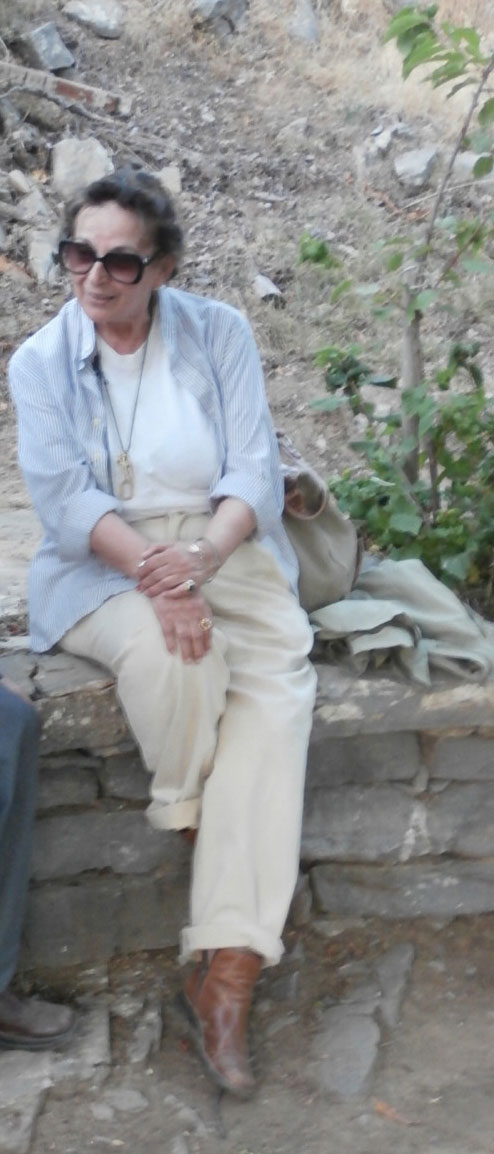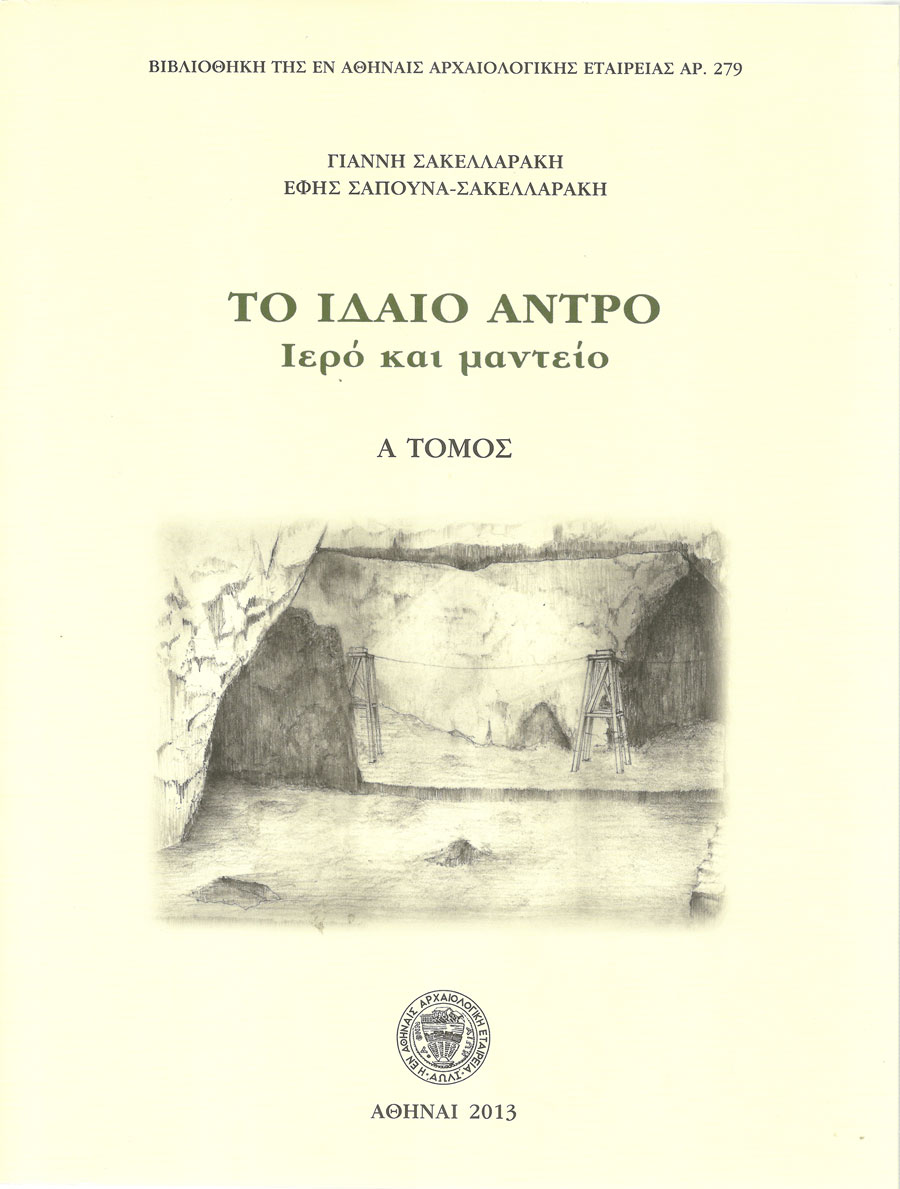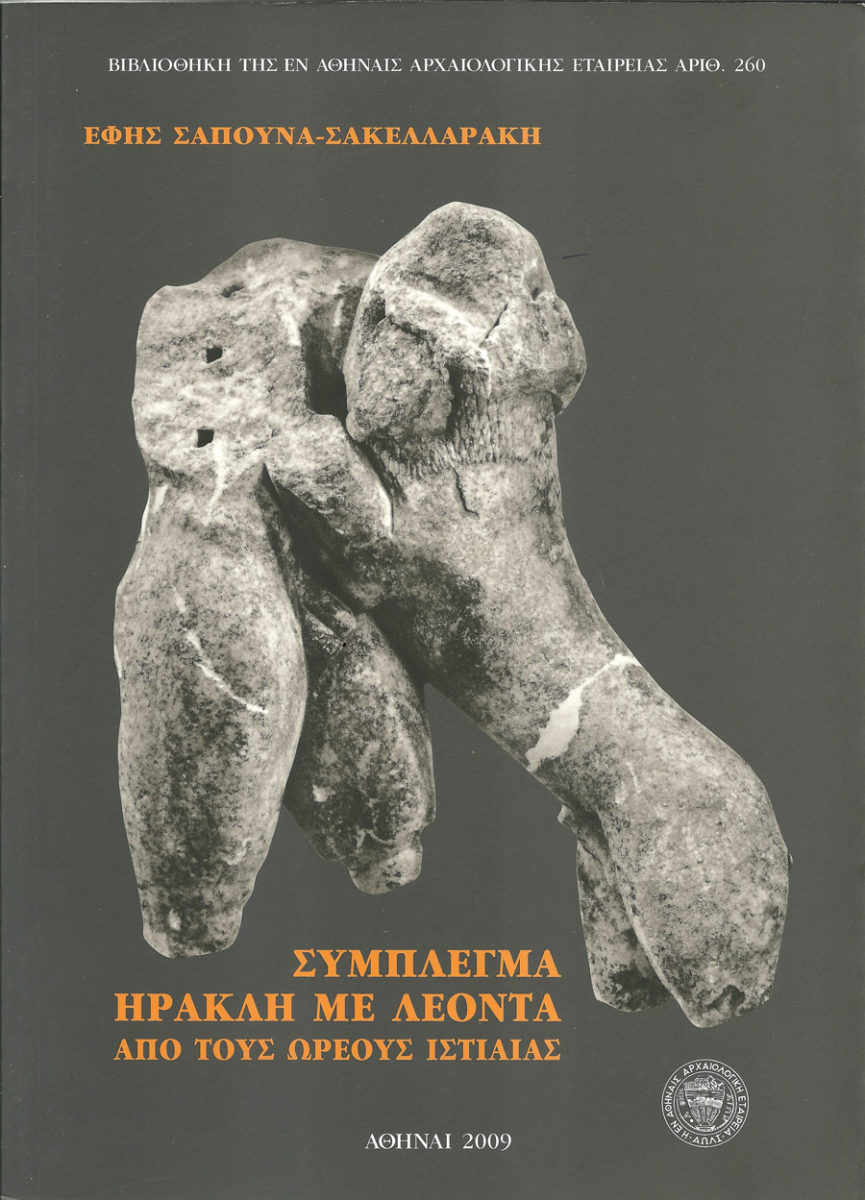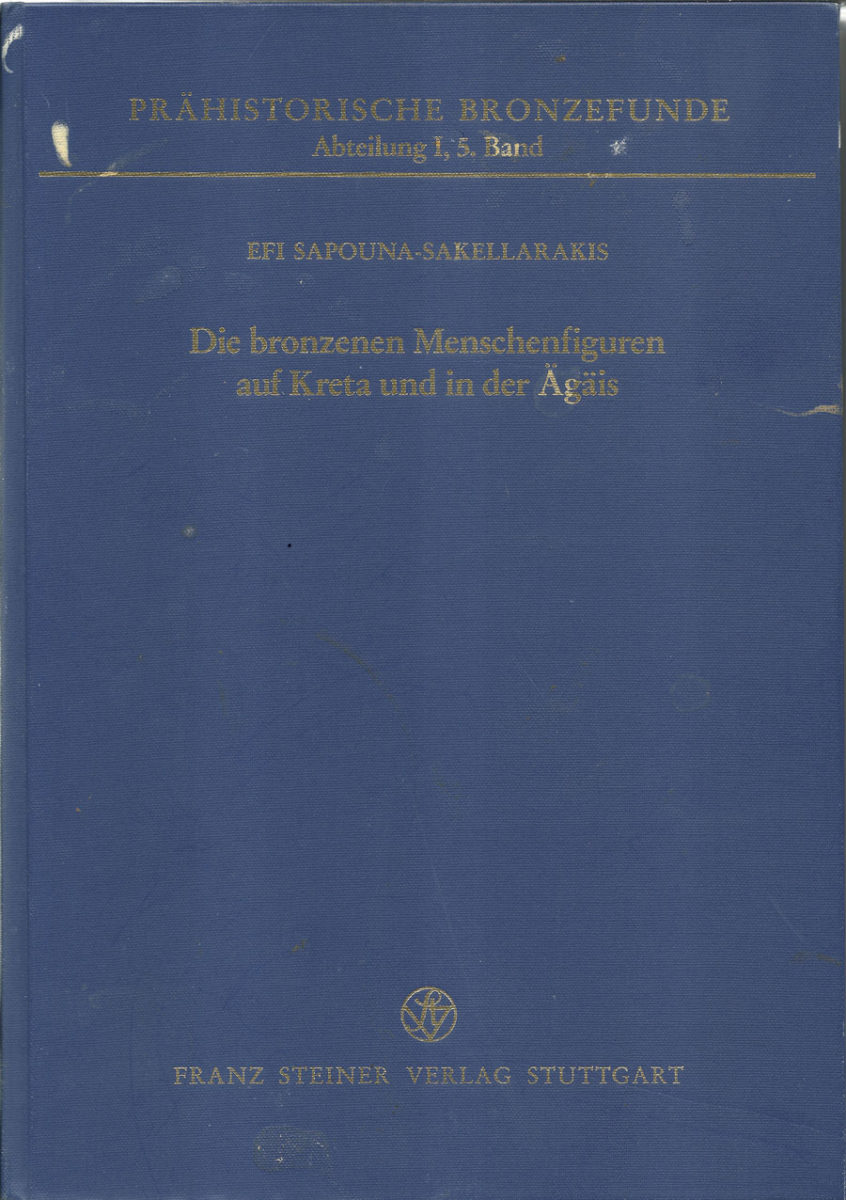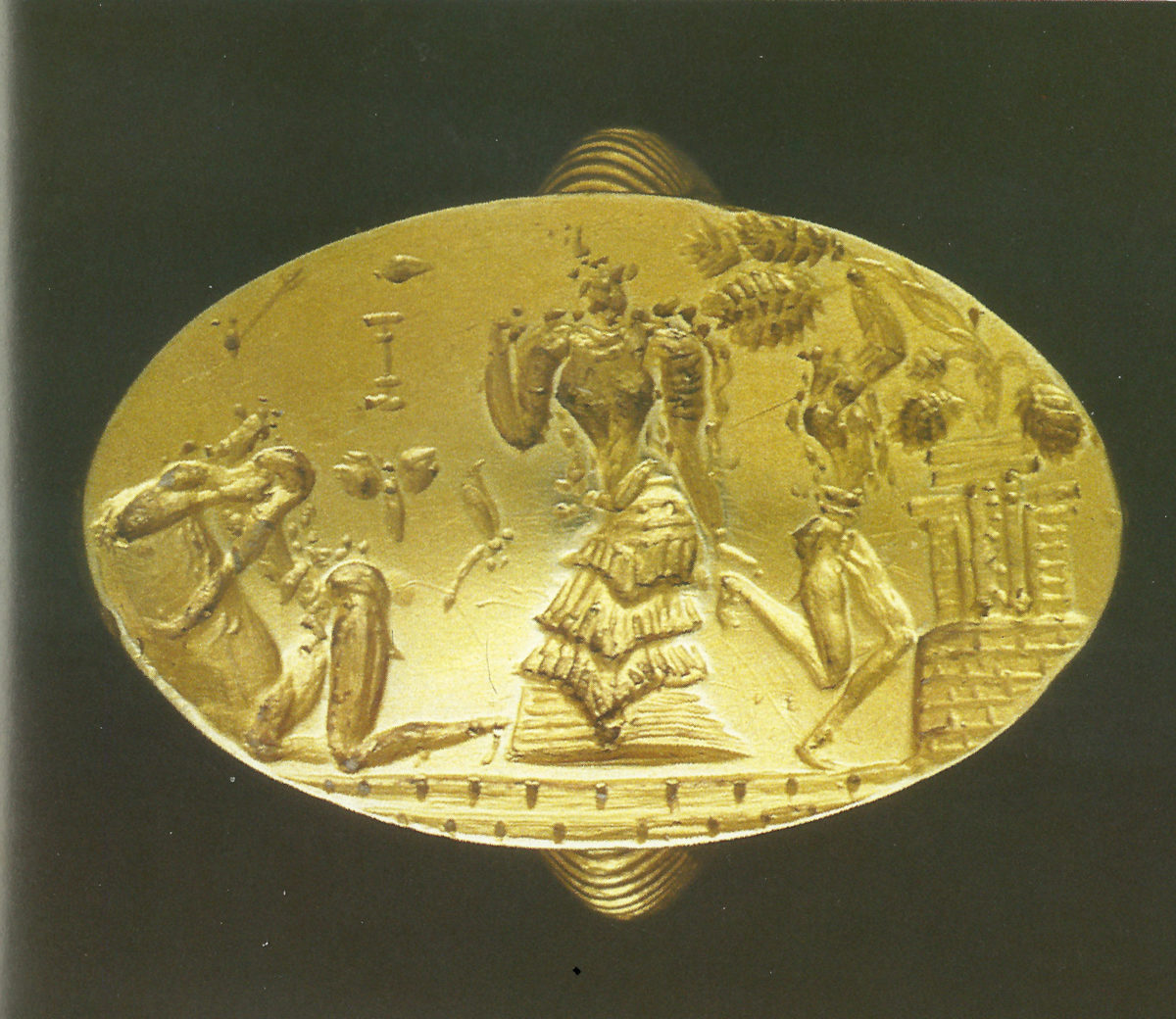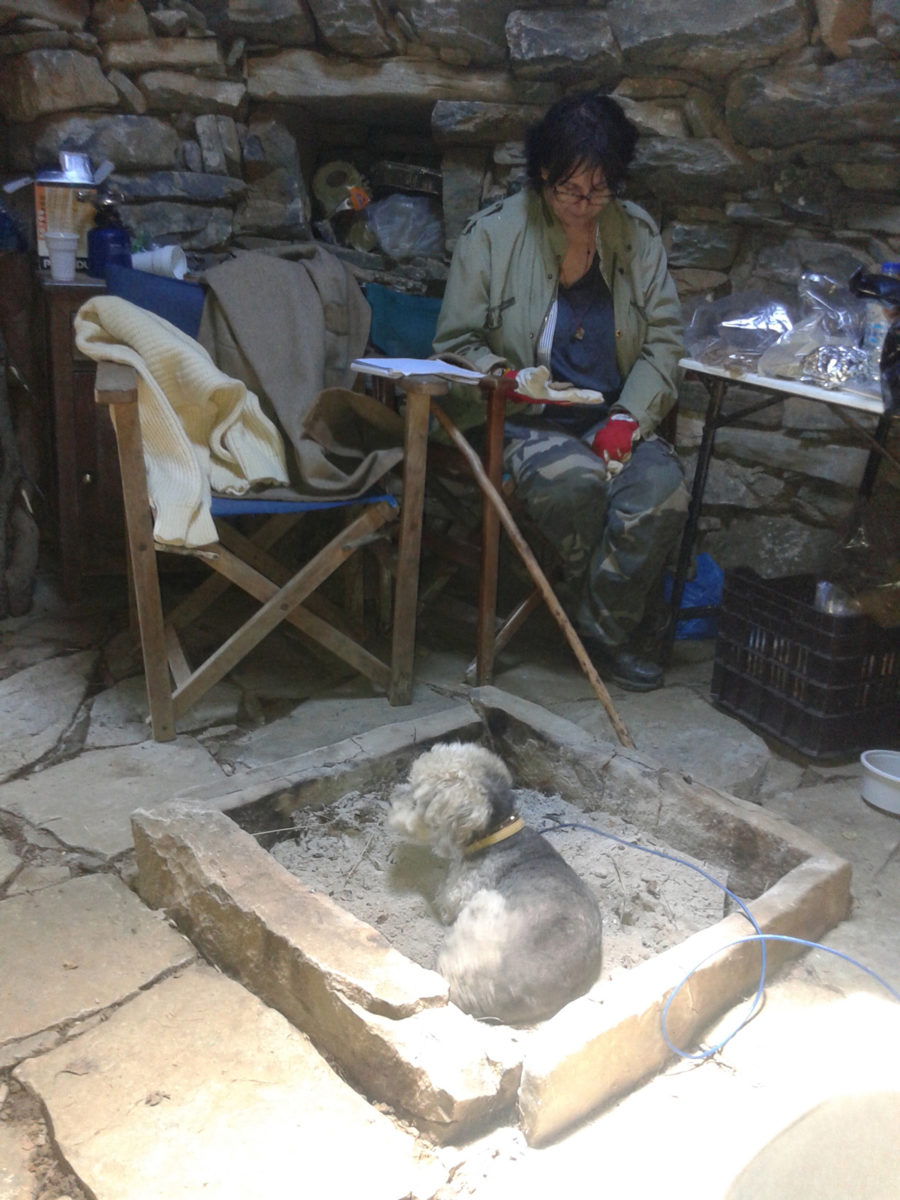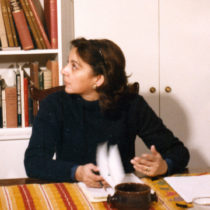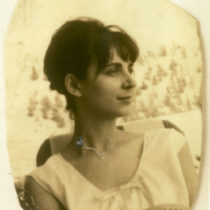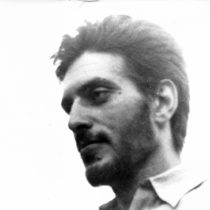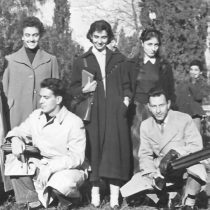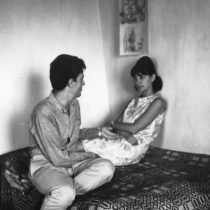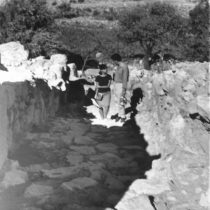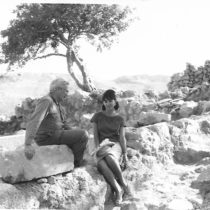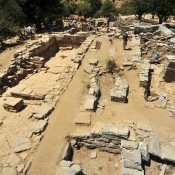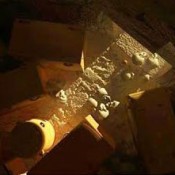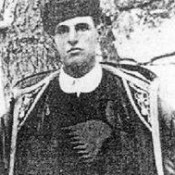Efi Sapouna-Sakellarakis welcomed us at her house in Drosia shortly before leaving for her excavation at Zominthos. We are warmly greeted by Othello (the 2nd) who, according to the wishes of Yannis Sakellarakis, took the place of Othello the 1st, whose painting now looks down on us from the wall. Two minutes after our introduction, Othello jumps into my lap.
Like other people, I suppose that I had identified this Lady of Archaeology with the excavations on Crete; Archanes, Fourni, Ideon Andron, Zominthos and their impressive results shared over the years with her husband Yannis Sakellarakis. While gathering information on her, however, I discovered that her interests go far beyond Minoan Crete. Her approximately 200 publications cover both prehistoric and Archaic times and include the Cyclades, Euboea, Skyros and Cythera. They specialize in figurines, study the wall paintings of Thera, Pylos and Crete, are to be found in big encyclopaedias whether British, Soviet or Italian, in proceedings of international conferences, in Greek and foreign scientific journals (Archaeological Bulletin, Athens Annals of Archaeology, BCH, BSA, Antike Kunst etc.). Two of her monographs in German concern island safety pins and bronze figurines of the Aegean. The topic of her doctoral thesis with Spyros Marinatos was The Minoan Loincloth (Vivliothiki tis en Athinais Archaiologikis Etaireias 71, Athens 1971). The Archaeological Society has also published her study on the Composition of Hercules with a lion from Oreoi in Istiaia: A contribution to the study of Archaic sculpture in Euboea (Vivliothiki tis en Athinais Archaiologikis Etaireias, Athens 2009).
From our discussion and the rich photographic material she has permitted us to publish, Mrs Sakellarakis comes across both as dynamic and particularly sensitive. We wish her to be rewarded by Zominthos for her devotion and tenacity.
Angeliki Rovatsou: Mrs Sakellarakis, I should first like to thank you very much for seeing me, just before leaving for Zominthos and despite being as you told me “swamped by work.” What are you involved in at the moment?
Efi Sapouna: Yes, I am tired. Currently I’m preparing the excavation at Zominthos while being involved with lots of other things, among which are the Cycladic figurines that I’m presenting at two conferences. I am now working on the Cycladic figurines in Acharnes, where we have found the largest assemblage in Crete ‒large, that is, compared to other Cycladic islands‒, while I have just finished with the extremely significant Cycladic figurines I also had the fortune to find in Euboea. I am also involved in an English translation of the book Cythera by Yannis Sakellarakis. A great part of my time is spent classifying our archive which I am donating to the Gennadius Library. I’m not giving it just as it is however, but classified. It is a very important archive; it includes, among other things, a correspondence beginning with great archaeologists we were fortunate to meet, such as Blegen, Schachenmayr and others, all those legends of Archaeology, as well as correspondence after my husband’s death, where important archaeologists such as Catling and Kopcke, among others, wrote me letters ranking us among the most important archaeologists in Crete of the second half of the 20th century. The archive also includes correspondence with our important friends, other scientists, invitations from all over the world for lectures and lessons, videos, diplomas, distinctions etc. I alone am in charge of all this, with one assistant. While Yannis was alive, we shared these things, including, of course, the excavation at Zominthos.
Α.R.: I would like us to talk mainly about yourself, but it is not that easy for one to distinguish you from your husband.
Ε.S.: By no means.
Α.R.: You conducted digs together, published many things together. Did you ever feel that he had a strong personality that overshadowed yours?
Ε.S.: Yes, he had a very strong personality. He overshadowed me, not purposely, but because I chose to take one step back. Actually, although everybody already knew my huge body of work (excavations, publications etc.), it is now, after his death, that they are discovering me: “We never imagined you were so dynamic,” they tell me. Yannis urged me to step into the limelight but I didn’t want to; I believed it was a bit awkward our appearing together like Laurel and Hardy. But as to overshadowing me, he did so, willingly on my part, but also because he was an imposing figure. I did not love being in the spotlight, whereas Yannis was in his element.
Α.R.: I would like you to comment on some points made in the memorial volume on Yannis Sakellarakis called I wish to speak about this memory… (Θα ήθελα αυτή τη μνήμη να την πω…) [published by the Vikelaia Library, edited by Efi Sapouna-Sakellarakis and Erietta Deligianni-Kotsi, Heraklion 2012]. You speak of difficulties, persecutions, betrayals….
Ε.S.: Very many.
Α.R.: …that are “serious allegations”. What are you referring to?
Ε.S.: First of all, I have to tell you that precisely because of Yannis’ strong personality, already from the start of his career, just out of University, he worked as a temporary archaeologist and then as a curator in Vrarona with Papadimitriou who singled him out. The moment Papadimitriou died, the persecutions began. Yannis wanted to go to Thessaly, he was appointed in Crete instead. Ofcourse, he benefitted from Crete. The great “discovery” of Acharnes was made in Crete. This was a palace searched for by Evans who named it the “summer palace” of Knossos, according to the Victorian prototypes of the period. After Evans, Platon and Marinatos had searched for it. It so happened we found it when we were very young, based however on very serious reasoning. It was not an accidental find. Regarding the discovery of Archanes, I should tell you that Zakros, where we headed upon arriving in Crete, was where Joseph Alsop, a famous American journalist, had also been. Alsop writes in the New Yorker of 1965, that Yannis took out a drawing of Archanes from the back pocket of his trousers and showed him a site in the village, exactly where the entrance of the palace was found. It is no coincidence however that at that same time we found Fourni, the most significant cemetery of the Aegean, with five vaulted tombs, funerary buildings and rich findings. Our excavations became internationally known (The Illustrated London News etc.) and were the cause for Yannis to be persecuted a second time, by sending him away from Crete, without giving offence however. We received a document from the Archaeological Society announcing that the excavations at Archanes would be undertaken by Marinatos, with whom I had begun my doctorate since I had not sat for entrance exams to the Service, as I wanted to be with Yannis. Marinatos also came, saw it and was rendered speechless, but the way we respectfully explained to him that we couldn’t accept this, convinced him to leave the excavation to Yannis and say “O.k., this is not my excavation”. Of course, perhaps this had coincided with his discovery of Thera at that time. However, when the Antiquities Director of Crete who resented our fame, sent Yannis away from the island, Marinatos, then Inspector General, didn’t hesitate to offer him a scholarship to Heidelberg from which he benefitted. When we returned from Germany and England with many qualifications, instead of being offered a decent position, Yannis was shunted round the country from Aegina to Yannena by the then Director of Antiquities. Until eventually Marinatos, wishing to set up the Thera exhibition, transferred him to the National Museum, thus successfully putting an end to this persecution.
Α.R : In the volume The Akrotiri in Thera. Thirty years of research 1967-1997(Library of the Archaeological Society at Athens, Athens 2008), its editor Christos Doumas who contributes the article “Religion at the Akrotiri” notes that “it was obvious from the first excavation trenches that Marinatos had the tendency to attribute a sacred nature to each find”. And he gives the example of a jar christened “sacred” by Marinatos, before even being removed from the soil.
Ε.S.: I would not agree that Marinatos made misguided assumptions. He must have seen something in the environment that prompted it, as in Evan’s case. Perhaps he didn’t carry out detailed documentation. I don’t know that. But he saw things clearly. Every era has its methods. In our time things are different. We archaeologists often don’t take pleasure from things during the excavation. We record every detail but very often lose the essence of things; a virtue possessed by Marinatos. He saw things as a whole, he was immensely knowledgeable and that is an attribute not found today among many archaeologists, attached as they are to typology. We tried to combine the two. Yannis used to say “Don’t just describe the object, e.g. ‘this bead has such and such dimensions and is made of agate’ but also think: what distant land did this stone come from? How did you discover it? What woman wore it? Why did she wear it? What was her status? Was she beautiful?.” In fact, Christos Boulotis, a very dear student of ours, who is now also a well known story teller, said when we were digging a royal vaulted tomb and found the deceased woman lying on the ground looking into a mirror “I dreamt she has blue eyes”. So what I want to say is that one should see something more than what you discover; be able to recreate it, resurrect it, enter the world inhabited by the tenants of a space, capture their spirit, their activities, always with data, of course. And now we come to the most significant find; the human sacrifice. At the time it was found, Yannis was the youngest lecturer at the University of Athens, when the title of lecturer meant something, unlike today when one starts off as assistant professor etc. You were not just obliged to submit your work before being assessed, but also to teach a class attended by professors and students. So he became a lecturer and then, when he wanted to apply for assistant professor, he was not made one, because the son of a professor was also a candidate and it was him they chose, based on the argument that “it was the first time Sakellarakis showed an interest in the University”. For a second time at the university he was again candidate for a professorship. Then the human sacrifice issue came up. Yannis was candidate for Athens and I was a candidate for the University of Thessaloniki. The great persecution occurred at this point. The human sacrifice is presented triumphantly in Athens and we depart for America, where it was presented at the Metropolitan Museum and at a seminar at the Archaeological Institute. The most important specialists of all fields related to archaeology were present there, as we had requested and the discussion lasted for hours. In fact, it was written by members of the Institute that it was the most significant and well documented presentation “ever”. We returned triumphant and on our doorstep found an invitation from the Archaeological Society for a “public discussion on the presentation of Mr Sakellarakis”. He had only been absent for a week and he was also on the Society’s Board of Directors; once again as the youngest advisor. After the first shock, we sat speechless and thought: What interests us and what is right? The chair –because all these things were happening for the university chair– or the truth, for which we had worked so hard? And of course we opted for the truth. Luckily, Yannis asked that the board be headed by Panagiotis Zepos who was a member of the Academy, professor at the Law School and member of the Society’s Council. Then all hell broke loose. Crowds of people had been invited. To cut a long story short, we won our case because all the foreign archaeological schools took our part, e.g. Hector Catling, Head of the British School and an important figure said “You are picking holes” when so many facts have been given. And Klaus Kilian from the German Archaeological School said “You want to read a book that has not been written yet”. Anyway, the discussion ended in our being exonerated and in… the loss of both Yanni’s chair and mine.
Α.R.: Excuse me. Was it just a matter of the chair or of archaeologists refusing to incorporate the “barbarian” practice of human sacrifice in an idealized image of antiquity?
Ε.S.: No. No the issue was not scientific. After us, everyone… has found a human sacrifice or human slaughter. Our critics had not even opened a relevant dictionary to look up the entry for “human sacrifice”. The discussion, which was really a “trial”, began with Nikolaos Platon who was the first to speak. When our first teacher of the Minoan period, whose involvement in this horrible story baffled us, questioned whether “human sacrifices took place or not”, Yannis showed him the book with his, Platon’s, university lectures where he wrote that “ human sacrifices could take place in times of crisis, but the practice of animal sacrifices was more usual”. After that, wise N. Platon fell silent and did not speak again. One of our older students who had not participated in this excavation and for whom we had secured a scholarship to Italy, in order to receive his doctorate from his professor in Athens, stood up and spoke incoherently. All the same, finally we won the day. As I said, we lost our university chairs, as we had already known we would, in advance. However, we won not only the love and trust of all the foreign archaeologists, but also of many Greeks who took our part, as for example the epigraphologist Constantina Delmouzou, the professor of Ancient History George Papantoniou and the member of the Academy of Athens Konstantinos Romeos. Thanks to all the publicity, we went round the world; we revisited the USA, went to Moscow, toured all of Europe as guests, as well as other places such as Egypt, Asia, Iraq etc. In fact everyone invited us and everyone thought it a well known fact that human sacrifices took place. One week after the “trial”, the English announced they had found a case of “cannibalism” at Knossos. No one batted an eyelid. Moreover, at a conference held at that time in Manchester called “Knossos and Archanes”, the English announced that years ago they had also discovered a human sacrifice, but they hadn’t dared say anything because people would be up in arms. And I have to tell you that this year, 35 years after the first announcement, a conference on Human sacrifice was held in Milan to which I was not invited, thanks to some foreigners overattached to Greeks who never forgive excellence, even though they, the foreigners, did apologize afterwards. Peter Warren defended our views at this conference and the existence of human sacrifices became generally accepted. Thirty-five years on we were completely exonerated. At that time however, persecution on the pretext of human sacrifice went beyond the limits of the university. On the eve of university elections and while Yannis was in charge of the archaeological collections of the National Museum, the Minister of Culture D. Nianias… appoints him by sending him off, over the phone, to Crete. Yannis, acting cleverly, leaves immediately for Crete and becomes Head of the Heraklion Museum and the Ephorate of Antiquities. With the completion of the unfortunate university elections, they wished to bring him back, but that was not possible, because the law does not permit a new transfer during the same year and so he remained another seven as Head in Heraklion. By this I want to stress the great lengths they went to in their persecution. On the other hand, Yannis was greatly loved by his students. Because at Athens University he had created a series of excellent students who hold important positions today. He was not, however, tolerated by the establishment. There were also a few betrayals by students, some of whom he had gone out of his way to help. That’s another story. We experienced many unpleasant events that we got over and moved on, perhaps because there were two of us. I got very offended by these things, while Yannis seemed to stay calm even though I fought for a solution. I shall now refer to a final characteristic example of “odium archaeologicum”, since it would be ridiculous to mention any more: A book, a Corpus Vasorum, was to be published by the Academy of Athens. It had been approved by Zakynthinos and Trypanis. It was ready, the Head of the British School had written an English prologue and suddenly three Greek colleagues of ours turned up, following orders from some academic for whose wife Crete was a contentious issue. So they arbitrarily decided that the Academy was not to publish it! And this was a book Yannis had worked so very hard on! The topic was the pictorial style in Mycenaean vases. We were in Syntagma square when we learnt about it. We went to the G.B. Corner for a meal and made an on the spot decision. The book was promptly published by Kapon Editions, funded by the Psycha Foundation after a favourable response from its Head Christina Stathatou. It is a very beautiful publication.
Α.R.: The rule of families in the “temple of knowledge”…
Ε.S.: Yes, exactly, in regards to the university. But I must tell you that the Ministry of Culture also never sent either of us abroad on a delegation, although as scientists we actively represented both Greek archaeology and Prehistory. Only once did they send Yannis to take the bull by the horns, when they wished to extract themselves from an awkward position, because Turkey, via the Council of Europe, had made a report called “The civilizations of Turkey”. He actually went, tackled the issue and they changed the title to “The civilizations of the East Coast” or something along those lines. Of course we went round the world because we were invited everywhere. Our joy in communicating went undiminished. Yannis taught successfully at the universities of Heidelberg and Hamburg, fulfilling his love of teaching. And I published two big German books among others, with the support of important scholarships.
Α.R.: Drawing once again on the volume in your husband’s memory, we find out that at some point you were both in the USA, on the East Coast where you and he gave lectures, studied the museums “always in the company of his wife Efi who was free, since she had been driven out by the dictatorship”
Ε.S.: I was driven out and left the Museum of Heraklion with other colleagues working on a temporary basis during the dictatorship and believe it or not I was writing my doctoral thesis with Marinatos, who was Inspector General at the time. Do you know what the paradox was? That having been to Germany with Yannis, we went to America where I was chosen by Homer Thompson, the old Head of the Ancient Agora, to become Secretary at the American School in charge of excavations at the Ancient Agora. In other words, they fire me from the Service and the moment I return, I find a position at the Ancient Agora; a responsible position given to me by the American School. And I didn’t curry any favours with them, because I restored some order there, while the Greeks in charge, even the older ones, didn’t dare speak up if by any chance they found some irregularity in the Stoa of Attalos. It is then that Thompson writes to me from the USA: “Efi, I admire your severe policy!” We had an excellent relationship nevertheless. It was seven years before I returned to the Greek Service. At that time I had just received my first German scholarship, thanks to which I wrote my first big German book on archaic and classical decorated safety pins of the islands. As is my habit, I burned the midnight oil, because the Ancient Agora had a 9 a.m.‒5 p.m. schedule. We were free on Saturday, so on weekends I toured all the islands to do research on my book’s topic. It was hard work. Once, in fact, in the Knights’ Palace in Rhodes, I was locked in the library at night by Gregoris Konstantinopoulos, Director of the Service, so as to work and find time to complete my study. Apart from these two important opportunities, the American School and the German scholarship, I was very fortunate to have shortly before collaborated on the History of the Greek Nation, where Yannis wrote an important chapter in the first volume. They had given me an important position in the Ekdotiki Athinon. And I was terribly lucky to share an office with Kyriakos Simopoulos. At that time Konstantinos Tsatsos popped by every day and we would have our morning coffee together. Ioannis Theodorakopoulos was not such a frequent visitor and of course Kostis Bastias, the co-director of the Ekdotiki Athinon was there, with whom, during our short breaks, we talked about everything from theatre to politics ,so I was very lucky in that respect. When I returned to the Greek Service after the fall of the dictatorship, I was offered a good position because I had my doctorates, the books etc.
Α.R.: Why had you been persecuted in 1967? Had you done something?
Ε.S.: I had done nothing. Perhaps it often happened at that time, although some temporary colleagues had in fact stayed on. It was just that my father was left wing. He was a dynamic person, he had fought in the mountains, had been in exile etc. This created personal difficulties for me in many instances, even during the entrance exams to the conservative Athens University where having been a runner up for other reasons, I was offered a place and ended up studying there. On the contrary, the University of Thessaloniki accepted me that same year.
Α.R.: So was the ideology of the candidates also scrutinized in the entrance exams?
Ε.S.: Of course, that was very much the case at that time. Because of that, my student years were very difficult but also very heroic, if you like, and I am very proud of that. I have lived during a time when ideas were really ideas and not party interests. Having lived with such a father has enriched my life tremendously.
Α.R.: You also mention something else in your last note called “in place of an epilogue”. You speak of a “Spring in Nauplion.”
Ε.S.: That is where the “romance” began. Yannis was always very serious and also had specific friends. He mainly spent time with Marina Karagatsi and her circle of friends. I was a “livelier” person. Initially I had other friends.
Α.R.: How did you meet?
Ε.S.: At University. While still a student he had worked in Nauplion, where he had been invited by Verdelis, the Antiquities Curator to help arrange the Tiryns artifacts in the Nauplion Museum ‒ unlike now, at that time students didn’t go on excavations that easily. Yannis then asked for some students. I don’t know why he chose me among others. I found him very remote, but oddly enough he wanted us to go for walks, eat together alone or with others. I ended up finding him interesting and he finally confessed he was in love with me.
Α.R.: How lovely!
Ε.S.: It was lovely, really lovely. And do you know something? On the last summer of his life, Ioanna Papantoniou asked me to donate my wedding dress to the “Brides” exhibition at the Benaki Museum. A little while before, Yannis, who was already ill, had asked me to revisit Nauplion before going to Crete. We went and I gave the wedding dress to Papantoniou, a heartbreaking moment, because it was as if this marriage was over and, on the way back, returning to Yannis who was waiting for me in a café on the front, I bought this ring with the aqua marine I’m wearing, which became a symbol of something ending, just as the wedding ring is a symbol of attachment. It was terribly….
Α.R.: Was it he who bought it for you?
Ε.S.: No, I bought it. I saw it and liked it for some strange reason. “Now I am alone” I thought. And I bought it because I saw that something was departing for good. Yes, it was such a story… I have to tell you that we often lived apart from one another. Studies abroad, teaching at foreign universities, seven years in Heraklion, lectures etc. Distance was good for us however, because there was always the expectation of our meeting again. In other words, even this distance over periods of time always created a new beginning. And of course when I returned to the Service, despite Yannis being in Crete, I wanted to go somewhere else. Besides he came for the courses at the university. And so I asked to be sent to Euboea, near our house in Drosia, since it was an hour’s train ride to Chalkis. In those fifteen years, I had the greatest scientific successes an archaeologist could wish for. For a start, I discovered and excavated Kymi, the city that founded the first colonies in the west along with the people of Chalkis. Since the century before last, archaeologists had spent years searching for it. I myself was searching to find it from the minute I went there. Returning from another excavation I was in charge of on Skyros, I stopped on Viglatouri hill and found the pile of stones that concealed an entire building. I said “we should dig here” and ancient Kymi came to light. The Italians, who have visited the site, consider it to be their “motherland”. It has now become accepted at conferences. When we went to Cuma in Italy, we saw that the settlers had chosen the same landscape. Another significant find of mine in Euboea is the huge sculptural complex of Hercules with the lion from Oreoi that has not been given the attention it deserves. Along with the Kouros of Samos, it is one of the most beautiful archaic finds from the last half of the 20th century.
Α.R.: And where is it exhibited?
Ε.S.: This work is not yet exhibited. I had it transferred to the storeroom in Eretria, because there is no museum in North Euboea and there have been several burglaries in some storerooms. A large museum is now being built in Central Euboea and of course it will be exhibited there. After that, I excavated at Amarynthos, where I found the important depository of the temple of Artemis Amarysia. In Manika near Chalkis, I excavated part of an Early Helladic city and cemetery where I found many Cycladic figurines. In Skyros, where Thucydides said the Athenians went to civilize the “barbarian” Skyrians, high-quality early attic ceramics were found, Phoenician artifacts, gold objects etc., which indicate that the Skyrians were far from barbarian. This changes the ancient historian’s view point that favours the Athenians. And of course, I located Mycenaean Aulis where buildings and ceramics were found from the period of the Trojan War. Classical Aulis had been found where the “Heracles” Cement Plant is today. So I made a good choice by going to Euboea which had not really been studied. I discovered a region that was untouched and with a very significant history.
Α.R.: That explains why you wrote the guides of the Archaeological Receipts Fund for Skyros, Eretria and Chalkis.
Ε.S.: That same period I set up the museums of Eretria and Chalkis. The Swiss gave the funds and so the storeroom and the museum of Eretria were both extended. Thus I transferred from Chalkis to Eretria the sculptures of Theseus and Antiope which came from the pediment of the Apollo Daphnephoros temple. This made the people of Chalkis very angry, but, OK, they forgave me afterwards. Besides, the Museum of Chalkis was not large enough and I was obliged to make another kind of museum planning. That is, I put the small artifacts inside and outside in arcades I placed the Roman statues, the inscriptions depending on what they represented, i.e. those that were related to athletics, or to public life. I copied them, translated them and so turned them into something interesting for the visitor to read and understand. In Karystos, I made a small museum in the Yokaleio Cultural Foundation, because the findings there were also thrown into storerooms, as well as the Skyros Museum which was a lovely building. Consequently, I wanted these museums to have small comprehensive guide books.
Α.R.: So this was your “personal destiny in Euboea” which, as you say, you followed.
Ε.S.: Exactly.
Α.R.: And you came to Crete when Yannis Sakellarakis was placed in Heraklion.
Ε.S.: Which we subsequently adored.
Α.R.: In a footnote to your book about the Hercules and Lion sculpture, you mention in a sharp tone that it was abducted by the head of the community ,while the Mayor of Eretria and the County Prefect destroyed the town’s ancient agora.
Ε.S.: What do you make of all that? Do you know what a struggle it was? They almost killed me in Eretria, when I went to verify the destruction of its ancient agora. This was caused by the slackness of a bad employee of the Service who had replaced me while I was away on academic leave. Even the stoa had been destroyed. When I arrived, the Mayor was coming straight at me with a bulldozer. Luckily the keeper arrived and promptly put me in the car, while they broke my assistant’s camera. The journalist Giorgos Votsis graphically described the events in Eretria in the “Eleftherotypia” newspaper; so much for Eretria. As for the Hercules statue, that was another tragic adventure. It was abducted by city councillors who had it in the Town Hall and were trampling on it. Then they took it to a fish tavern and laid it down in a corner. Outside was a plaque writing “Museum”, fish etc. The journalist Katerina Daskalakis wrote many articles in the “Mesimvrini” newspaper. When the Mayor changed, we organized an anti-kidnapping in collaboration with the police and a prosecutor who escorted us. We went with the police and the Mayor and put the statue in a truck. I then saw that it was safely guarded in a museum like that of Eretria and now of course it will be placed in a prominent place in the museum under construction. My colleagues may perhaps have similar stories to tell…
Α.R.: Nevertheless, in this case the Ministry of Culture did not act appropriately.
Ε.S.: No way. Of course not.
Α.R.: I mean, shouldn’t someone have stood up for you and covered for you somehow?
Ε.S.: No one covered for me in either case; so many difficulties without any support. In Manika, near Chalkis, where a unique prehistoric settlement was discovered, all the ministers in office said to me “we cannot expropriate it”. So, it was backfilled. In Aedipsos, what is essentially nothing more than a cave is known as “Sylla’s baths”. In a district where important statues had been found at the beginning of the century, I found an entire Roman bath house which would have been a wonderful ornament for Aedipsos. In this case as well, the owner of an apartment block threatened to kill me, because the secretary general of the Ministry had referred him to me, while the Central Archaeological Council decided to “preserve it buried”. It was not destroyed, but buried under the apartment block. Not even the mayor of the rich municipality of Aedipsos offered to help. I had just returned from Baden Baden and Bath and in both Germany and England had seen, in some cases, baths with steps and a glass covering under an apartment block. Wonderful! The only thing I managed to do was gather various ancient pieces scattered all over the town of Aedipsos and get in touch with the local head of the Tourist Board to place them in the new Hydrotherapy Centre, in a small room exhibiting the history of baths. We also displayed some statues in the entrance, some inscriptions in the garden and pedestals in an open air museum. In other words, this was a struggle without any support, other than the amazing willingness and help of the Ephorate’s staff who had believed in my vision.
Α.R.: Let me ask you something else I wondered about when reading your book on the sculpture complex of Hercules and the Lion, an inscribed votive offering (Κυλίων ανέθεκεν) from the 2nd quarter of the 6th century BC. You refer twice to Karouzos, to a text of his of 1941. The first time he says “beauty cannot be separated from the material (of its construction)”and later that “the pilgrim who has his name inscribed on it, is convinced that the work is ‘exceedingly beautiful’”. I think you wish to tell us something that emphasizes this perception of beauty.
Ε.S.: I agree with what was said by Karouzos, who was a great archaeologist and aesthete. He sees it from its aesthetic side. There is also however the aspect of the donor’s social recognition. He who had his name inscribed wanted to honour his line and his aristocratic origins. Very often, in fact, aristocrats trace their origins to some hero; in this case to Hercules. Let’s not forget that a bit further up, in Lichada, is the site where Deianira sent the hero the poisoned chiton. Hercules is associated with the entire region.
Α.R.: In the memorial volume for your husband we read that in 1979 you were the one who located the Anemospelia. How did it happen?
Ε.S.: I always conducted a survey with the students so as to study the region’s topography. On one of those tours I found a small section of a “sacred horn” which meant that something important was there. I said so to Yannis and we dashed off to the site the following day. It was March, when no excavations were going on. So the human sacrifice sanctuary was located. That summer, an excavation began with results that are well known.
Α.R.: What plans do you have for your excavation this year?
Ε.S.: What I wish to do this year is to continue research in the main building of Zominthos, that big building complex on Psiloritis. It’s a very impressive building. After Yannis’ death I conducted geomagnetic surveys to determine the surviving boundaries, because a large section has been destroyed by crops. The main building however is intact. The objective therefore is to excavate new areas in the building as well as floors, specifically some rooms which clearly have a third floor. I want to finish with this building, because to the east, 100 metres from the other side, is a smaller Mycenaean building that must be excavated. Zominthos is an important site. When Yannis said to me that it was the biggest excavation of his life, I didn’t believe it, but I see now that it must have been the settlement of some members of Knossos’ royal dynasty which had control of the region. This is made apparent not just by the brilliant architecture, the workshops, the very beautiful finds such as the double axes, some of the most beautiful bronze figurines in Minoan Crete, the seals, jewelry, wall paintings we conserve in the winter and which have started to reveal floral motifs. It is however the location that is of primary importance, i.e. on the road to the Ideon Andron, which is not accessible for many months; there is still snow in June. The first time, since the ones in the 19th century, that Yannis started fresh excavations at the Ideon, he dug into four metres of snow to reach the archaeological layer of this extremely important sanctuary. Homer Thompson who excavated the ancient Agora writes in an article about our excavations published in the New York Times that, to the history of religion in Crete the Ideon Andron is what the Grand Canyon is to the natural history of North America. And whatever has been found in the Ideon Andron, from Neolithic up to Roman times, is of equal value with artifacts found in Delphi or Olympia: large shields, figurines, jewelry, even parts of an ivory throne. The worship of the Cretan born Zeus was not restricted to a pilgrimage lasting a few months. Worshippers flocked from all over the near East, from Mesopotamia, Syria, Egypt and Cyprus. For the remaining months, the place of worship must have been transferred to a more accessible winter site. There must also have been a dwelling place for the priests who usually came from a royal family. The nearest road from Knossos to the Ideon Andron, the one referred to by Plato in his Laws, passes through Zominthos. Supposedly, Plato himself had been to the Ideon Andron. And Zominthos is situated exactly on this crossroad. It is accessible in the winter, it is more than a palace and clearly it was a place of worship when the Ideon was not functioning. What’s more, from what we know by studying the rest of the finds ‒and I’m not talking about the zoological finds that include all the well known animals found in Crete such as cattle, sheep, deer of the dama dama breed etc.‒ paleobotanical research in the area found seeds of familiar plants, but also of millet which had not been found before in Crete. This is a product that would have been brought from more northern regions, I do not know for what reason and we shall look into that. It appears that the tenants of the building had connections with other regions. It may be accidental; perhaps these plant components had not been so thoroughly examined in other areas. But it does show they had multiple activities. Another basic product was wool with which they supplied Knossos. And it is known from its inscriptions that the main export of Knossos was lambs’ wool that is also mentioned in Egyptian sources. We also learn from Egyptian catalogues that apart from wool they imported healing and aromatic plants from Crete. And Psiloritis is full of such plants. Therefore, Zominthos was a centre of worship and a centre of production. Wishing to restore nature to its original state as described by ancient writers, Yannis planted trees and plants and started to prune various bushes for them to grow into trees. It has now become a forest centered round the excavation site’s Krataigos or May tree which has been declared a “monument of nature”. I am carrying on this work with part of the excavation funds.
Α.R.: Some time ago, Christos Doumas said to us “Without denying religion’s existence, when I do not know about it, I can describe neither the ritual, its structures, let alone its content. If one looks at the archaeology of Crete, we have constructed temples, priests, a ‘king -priest’ etc. When, however, you do not know about a society, its structures and organization, you cannot make constructions that surpass your data”.
Ε.S.: Do you think perhaps he was joking as he sometimes does? Because the wall paintings in Thera give us so much information; all those female figures or all the ritual with men depicted climbing the stairs holding vessels or the little priestess holding that incense burner; in other words, a lot of visual information has been found in Thera that proves the existence of some rituals. Of course, we cannot call all of these sacred, because there are also archaeologists who give that term to everything they find.
Α.R.: From your great experience, would you speak of “Minoan religion” and “Minoan worship”?
Ε.S.: Religion is a big chapter in the history of humanity and worship is the way various religious rules are put into practice. Of course there is a Minoan religion, but there is also the cult of the Great Goddess and her associate, the Young God. These are rendered pictorially since we do not have texts. Often one can recognize rites of the cult in the iconography. In certain cases, one could even speak of magic when finding “magic knots”. Each time all these things must be examined meticulously, in relation to religion of the historical era where texts exist and also in relation to research of current religions in societies going through the same stage in their culture as Minoan Crete. We should have a wider knowledge of ethnology when interpreting ancient phenomena. When dealing with human sacrifice, we had examined ancient civilizations and as well as what happens with the Maya, the examples mentioned by Pausanias, practices in the classical era, so as to interpret a finding that, till then, was unique. Human sacrifice always occurred for the greater good and to avoid some catastrophe. Shortly after our lecture at the Metropolitan Museum, a poem was published in the New Yorker by the then greatest living American poet, Robert Penn Warren called “Looking Northward, Aegeanward”. A poem that refers to human sacrifice, where he poetically describes this entire story and writes: “but the eyes of the unbelievers will not believe”. I must tell you, however, about the most wonderful article ever written about human sacrifice that shows precisely the meaning of sacrifice; it contains the concept of faith in something. Among many articles written at the time, it had been insisted by an important friend of my father that some lady from the Gynaika magazine come to interview us. We did not want that initially. Finally the journalist came to our house. She was to stay just half an hour because we had no time to spare and instead ended up staying five hours. She was a wonderful woman with unlimited knowledge, who drew upon a multitude of similar examples from ethnology that one could not begin to imagine. We had a long discussion about human sacrifice and as she left she said to us “And if nobody believes in human sacrifice, I certainly do and I have been subjected to it”. After she’d left, Yannis and I thought that “it must have been some disappointment in love”. And then we read the article that spoke about sacrifice, sacrifice for our homeland, the meaning of “I sacrifice myself”. “We never think of sacrifice as something bad, we think of it as something sacred”. This lady was the wife of Nikos Belogiannis, the well known writer Elli Pappa. We were deeply moved by this article and along with Penn Warren’s poem I believe it was a tribute to us and our scientific point of view. They counted much more than our being recognized in America and everything positive written about us, more than the invitation to the Academy of Sciences in Moscow. There, apart from the lecture in the Pushkin Museum, we also presented the topic on television in a programme by Piotr Kapitsa (Nobel Prize in Physics). He himself commented that it is mainly the Greeks who sacrifice themselves for many things, so he was puzzled that there were Greeks who doubted this practice. What I’m saying is that in Minoan Crete there is faith in the divine, to which they resort in difficult times. But it is difficult to talk superficially about religion and worship.
Α.R.: Let me ask you about something else. I found your thesis on the Minoan loincloth extremely interesting, moving as it does between archaeology and costume design. Have I understood correctly? Is this Minoan male dress with a cod-piece exclusively Minoan?
Ε.S.: Yes. Look, the cod-piece was also worn by men from other peoples, but this type, especially the loincloth, is purely Minoan. All the visual elements, even the decoration on the clothes of the Keftiu/Cretans depicted in the tombs of Thebes in Egypt, are purely Minoan. As we have said, the Keftiu wearing this garment are Cretans. They are holding objects that are clearly Cretan. There are many other elements that prove the uniqueness of the Minoan male garment and especially the variety of figurines, seals, rings, wall paintings which depict both the simplest male garments in one colour for daily use, as well as luxurious ones embroidered and richly decorated.
Α.R.: Looking at photographs in the memorial volume on Yannis Sakellarakis, one sees many famous people from the art world.
Ε.S.: We were fortunate to have good friends from early on in our lives and to meet important people who I can only mention indicatively here. The well known artist Yannis Kounellis whom we met up with ever time he came to Greece, is a childhood friend of Yannis. Angelos and Maria Delivorrias and Marina Karagatsi are friends from our younger days with whom we keep up a warm relationship, though not on a daily basis. The same goes for Nikos Koundouros whom we meet more often in Crete. During our time in Germany, we became close with the family of our very close friend Andreas Furtwängler, son of the well known conductor, whose first child we have christened. Through Andreas’ sweet mother Elizabeth we met the great 20th century artist Oscar Kokoschka who was a friend of the Furtwänglers and who wrote on a painting he gave us “a small repayment for what you gave me”. He was almost 100 years old when we met him, but we met several times either in Switzerland or at our home in Athens and Drosia. I remember him telling us, while looking at the works of some well known Greek painters we had at home, that he liked a mediocre painting we had by Fassianos, even though he hadn’t been familiar with this painter’s work. And I remember cheekily telling him that I liked the period when he painted himself and Alma, Gustav Mahler’s wife, whom he was in love with. Let me mention that I was very fond of Kokoschka’s wife Olda. For many years we saw a lot of Stavros Xarchakos, who was a close friend of Yannis as was Andreas Furtwängler and later on the film director Theodoros Angelopoulos. George Embiricos and his wife Maria offered us countless moments of intellectual pleasure and endless conversations. Through the Embiricos couple we met and befriended Picasso, particularly his son Claude with whom Yannis was preparing a book on the Minotaur. Not an archaeological one. When does the Minotaur appear? From Yanni’s book we learn that he usually appeared during difficult times. Yannis had gathered all the relevant material; poetry, painting, theatre. It is an unpublished work and now it is my task to publish it. Claude Picasso will publish his father’s drawings which are in the Reina Sofia Museum in Madrid and are a whole series, apart from the great painter’s other works. Claude’s mother, the famous Françoise Gilot, a clever, charming woman, warmly embraced this friendship and collaboration. We also have very many dear Greek friends such as Adonis Kyrou and Maria, among our oldest and dearest friends, Eleni and Pavlos Kalligas, the Fostiropoulos family with whom we went on so many wonderful travels, the Votsis couple, adorable Dora Stratou, the family of Spyros Vasileiou with whom we have spent many good times, Iakovos Kambanellis and later on Yannis Parmakelis and the Tsoklis couple. But also among our friends were the musicians of the Orchestra of Colours, Ioulita, Kouroupos, Sakkas, Logiades, the younger Tsalachouris, the actors of Karolos Koun’s Arts Theatre, Lazanis, Pittaki and many others. What kept us going during the attacks we suffered were our friends who were always near us, even though we never spoke of our troubles to them. We got over everything thanks to them. It is very important to have a healthy environment and not to restrict oneself only to archaeology; to listen to music and go to the theatre. For example, we went to Brecht’s Berliner Ensemble theatre in East Berlin when it was forbidden, because of the Wall and the strict control at Check Point Charlie. We wanted to enjoy a good performance despite the restrictions of the junta. We were completely mad, chasing art wherever it exists. This was what really mattered. I believe this describes us both as a couple and fortunately we both had the same taste for such pleasures.
Α.R.: One understands this when reading the memorial volume. One sees a great love of life.
Ε.S.: Yes. When I’m invited somewhere interesting, I never say I can’t go because I’m working. When I want to enjoy something, I do just that. When they ask me “how come you’ve written so many books” I reply “I wrote them when I had nothing better to do”. I mean that. And afterwards I go home and bury myself in my work. Till late. My assistant comes in the morning, puts the USB stick in the computer to save the text and says to me “Once again you went to bed at 3 in the morning!” And not knowing it, I asked her the first time round “How did you guess, Myrto?” “A spy told me” she replied. What I’m saying is that I work like mad, but there are also other important things in my life and right now I have my little dog Othello who is marvelous and… a good excavator.”
Angeliki Rovatsou is a Historian and Social Anthropologist and writes for “Archaeology and Arts”
